For me, autumn is a time of richness as the gardening season nears its end in an explosion of pigments and seedheads. Those pigments, in particular, have always fascinated me and I made a concerted effort to use brilliant fall foliage colours in my own garden design. So today’s fairy crown, the 26th, features the fall leaves and fruit of shrubs and trees in my Toronto garden in early November, including Japanese maple (Acer palmatum), Washington thorn (Crataegus phaenopyrum), burning bush (Euonymus alatus ‘Compactus’), barberry (Berberis thunbergii ‘Rose Glow’) and, draped down my front, a compound leaf of my black walnut (Juglans nigra).
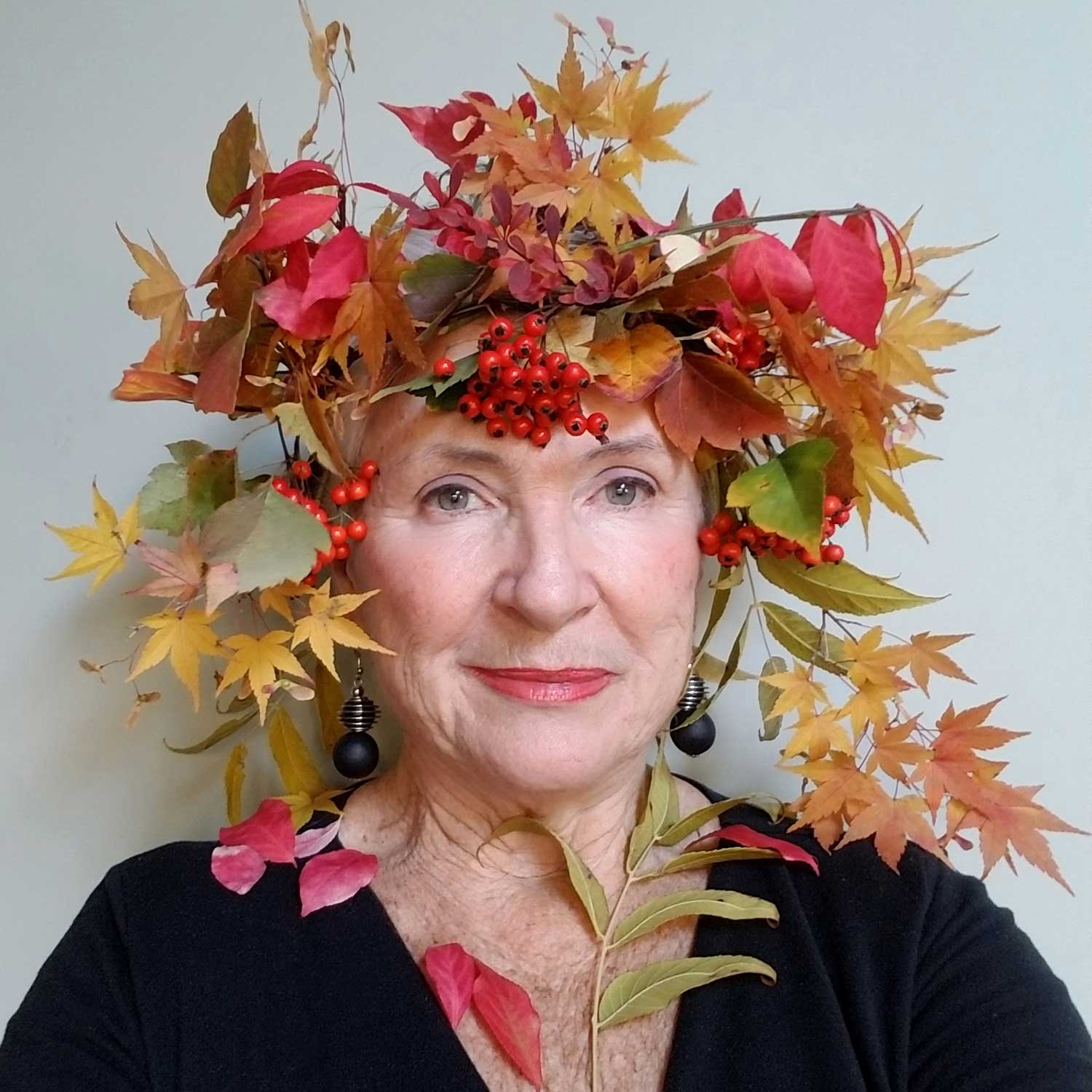
Every year is a little different in terms of the parade of colour. Here you see my Japanese maple showing off its regular autumn leaf change as the burning bush hedge turns colour. In the pollinator garden, the ‘Autumn Joy’ sedum seedheads are ruby-red, but the fothergilla haven’t begun to change yet. The columnar red maple (upper left) that the city chose for my boulevard (I asked for one that turns red) has taken on its disappointing dishwater-yellow. Red maples, of course, don’t always turn red in fall.
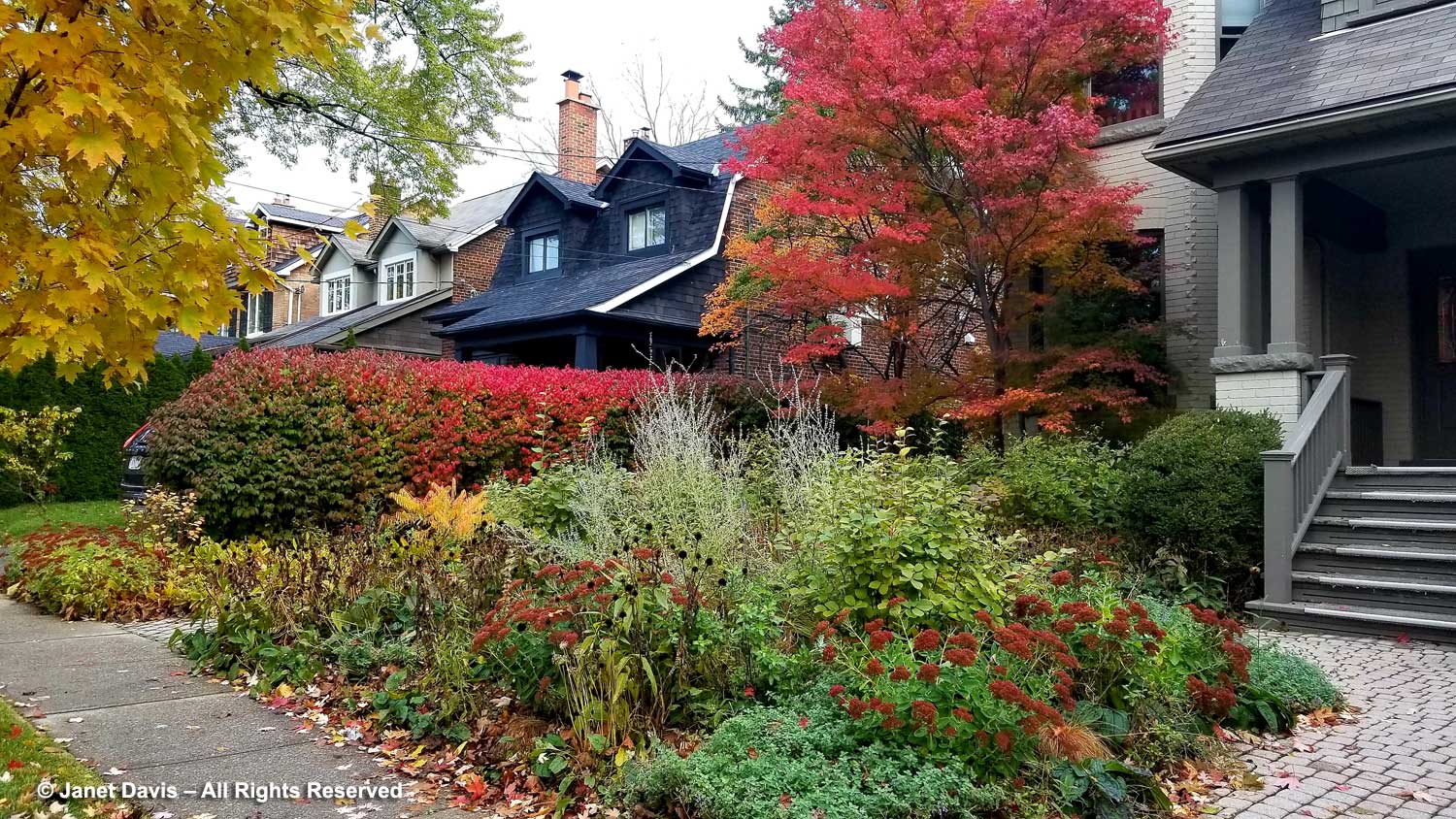
In this photo taken a different year, the fothergilla in the pollinator garden is a rosy-apricot. That’s catmint in the front giving a nice glaucous contrast with Russian sage and echinacea seedheads adding structure.
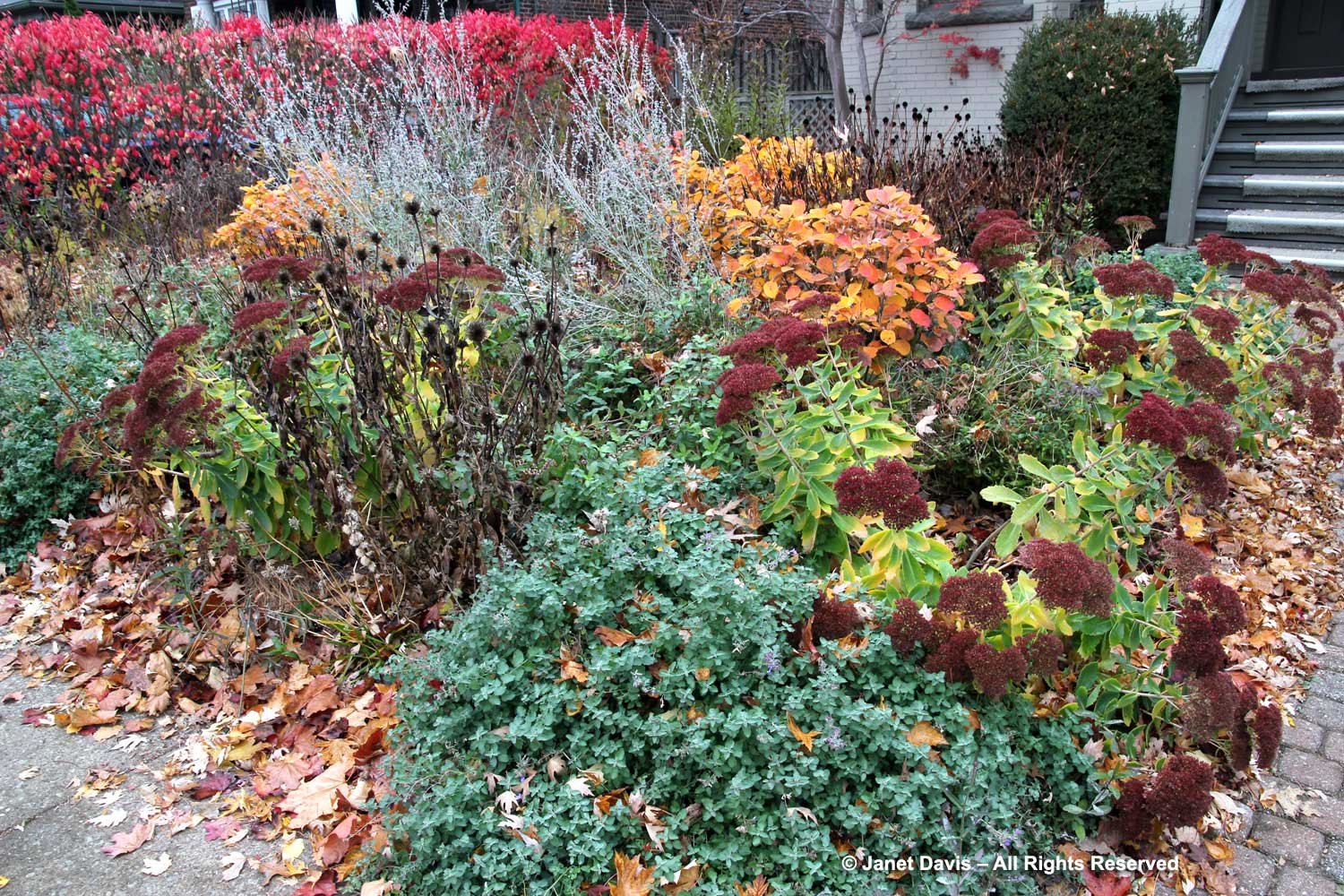
From across the street, my neighbours see my garden through the fan-shaped yellow leaves of my second boulevard tree, a ginkgo (G. biloba).
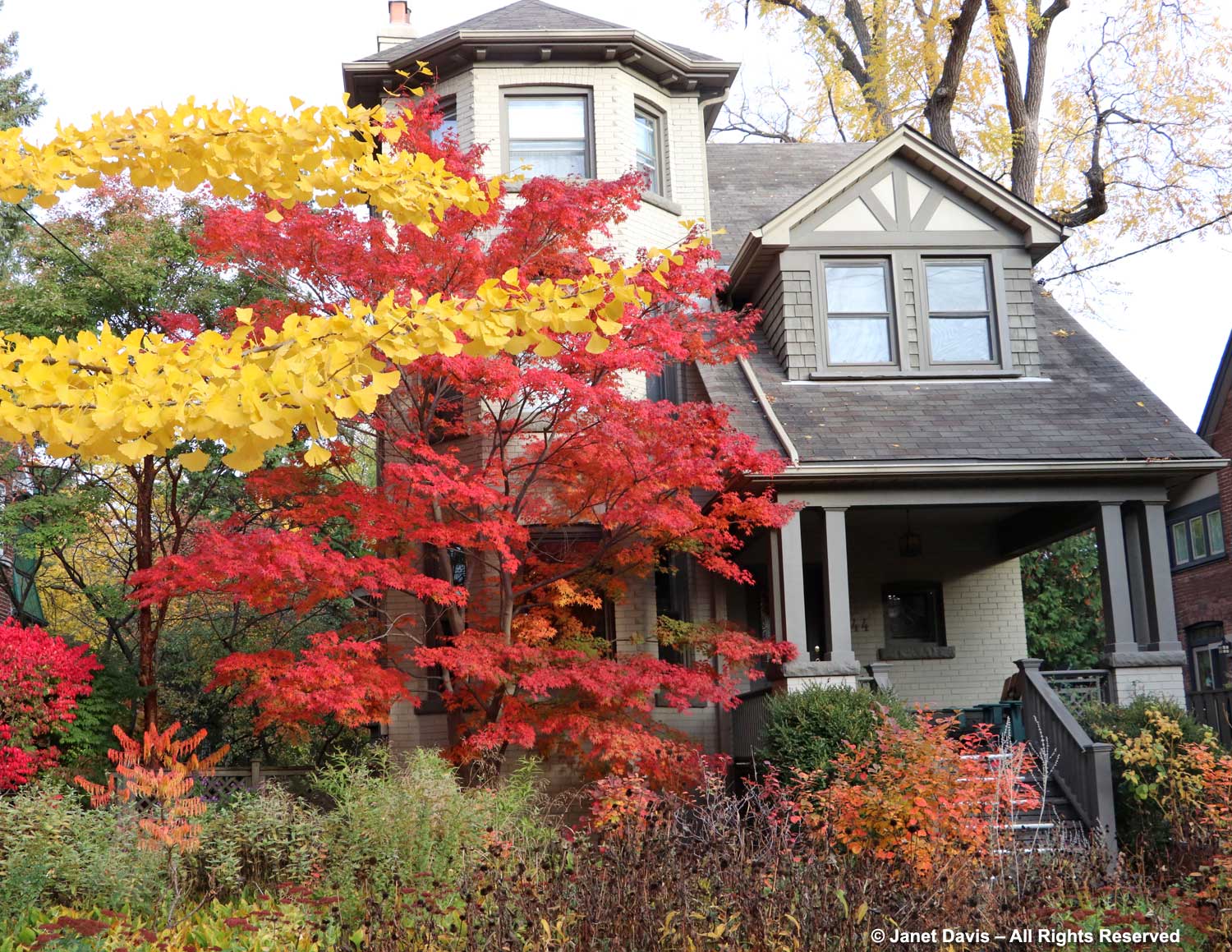
If you’ve followed my blog for a while, you likely know that I’ve had fun turning those yellow leaves….
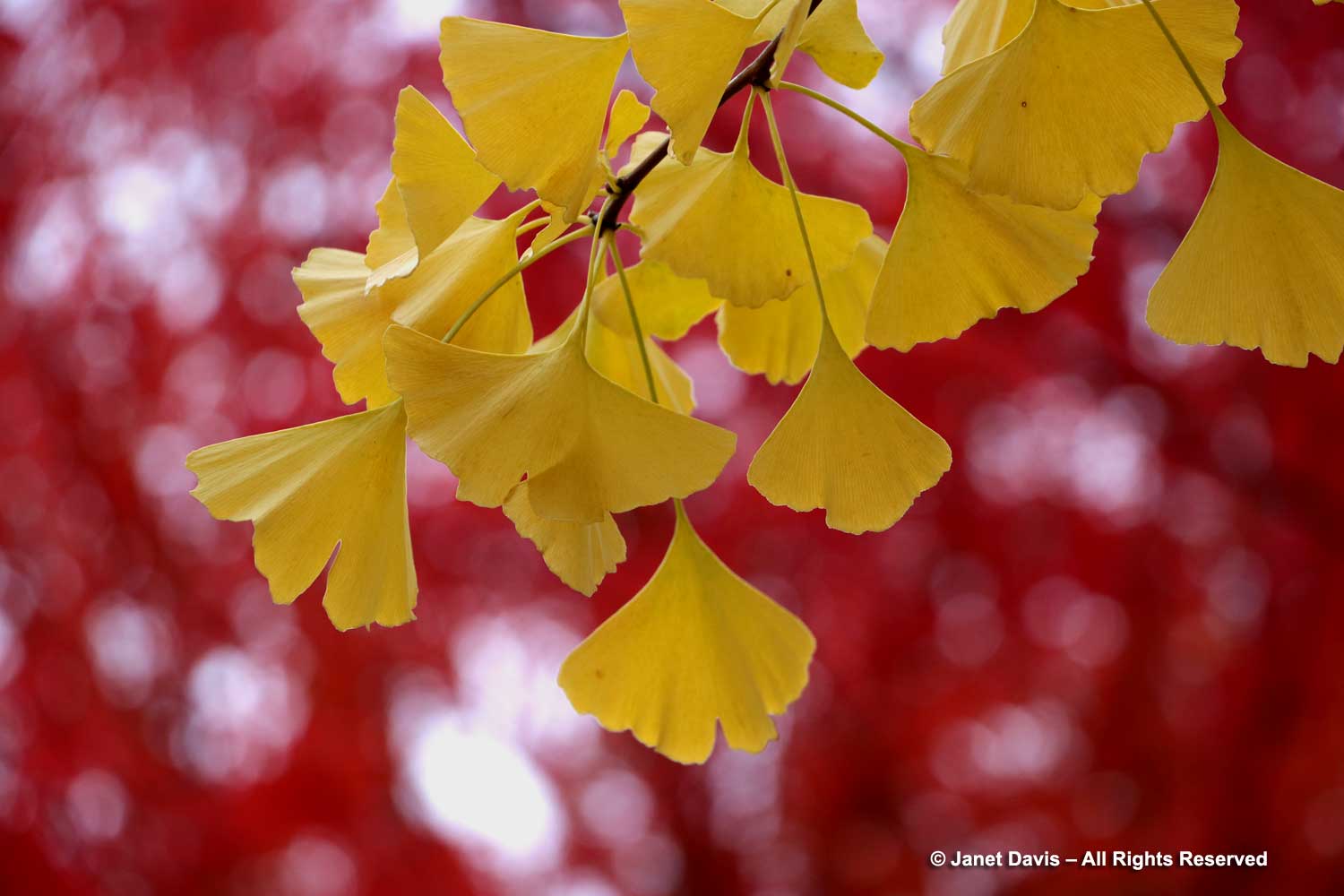
….. into ballet tutus of tiny dancers.
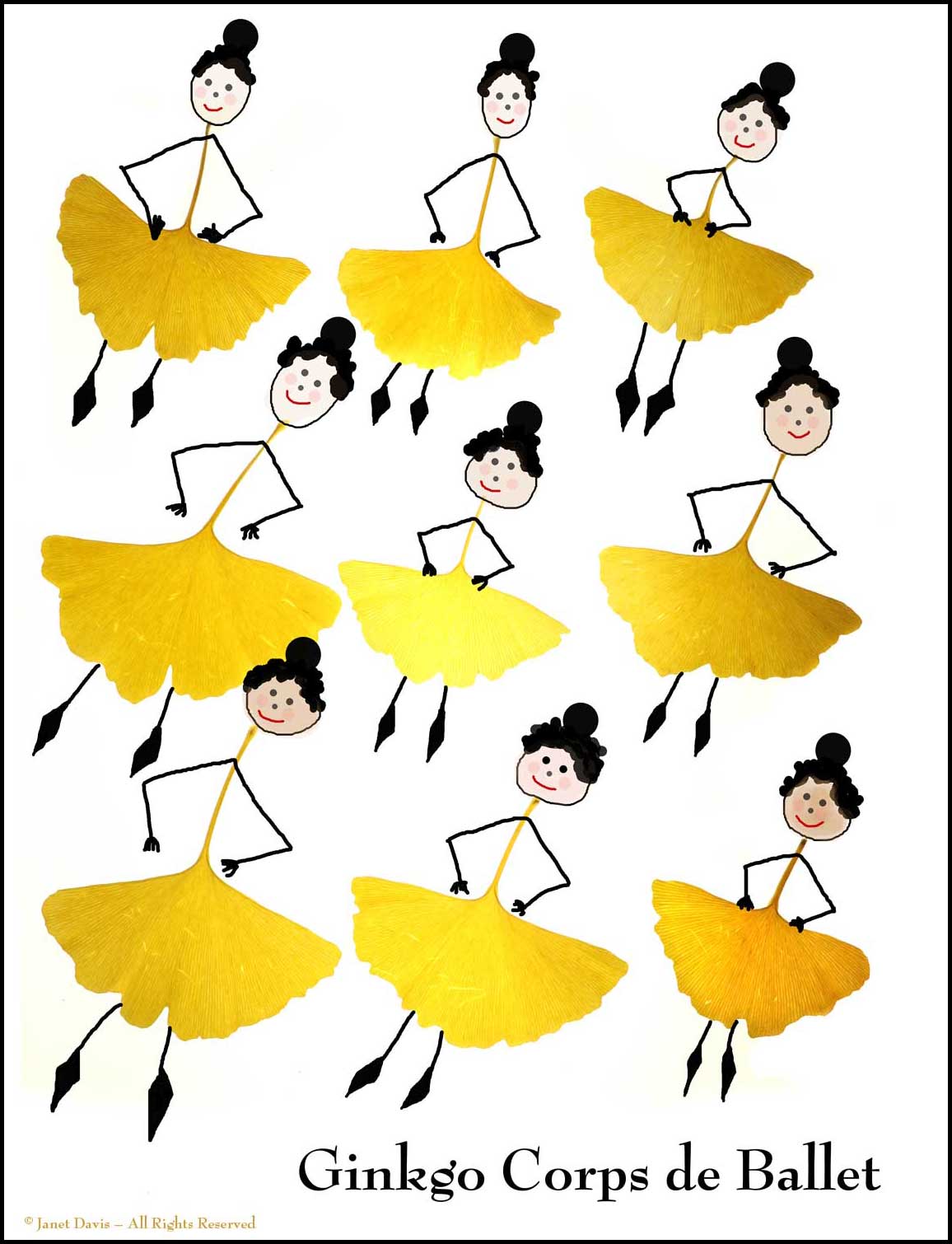
The Japanese maple (Acer palmatum) I planted in front of my living room window decades ago is a great joy to me. It’s the straight species with green leaves – in Japan it would be a common forest tree. But in my garden, since there are no drapes on my front window, it forms a lacy curtain from spring (when bees buzz around the tiny May flowers) to fall. In very late October or the first week of November, the foliage turns a range of rich hues from yellow to apricot, scarlet and crimson.
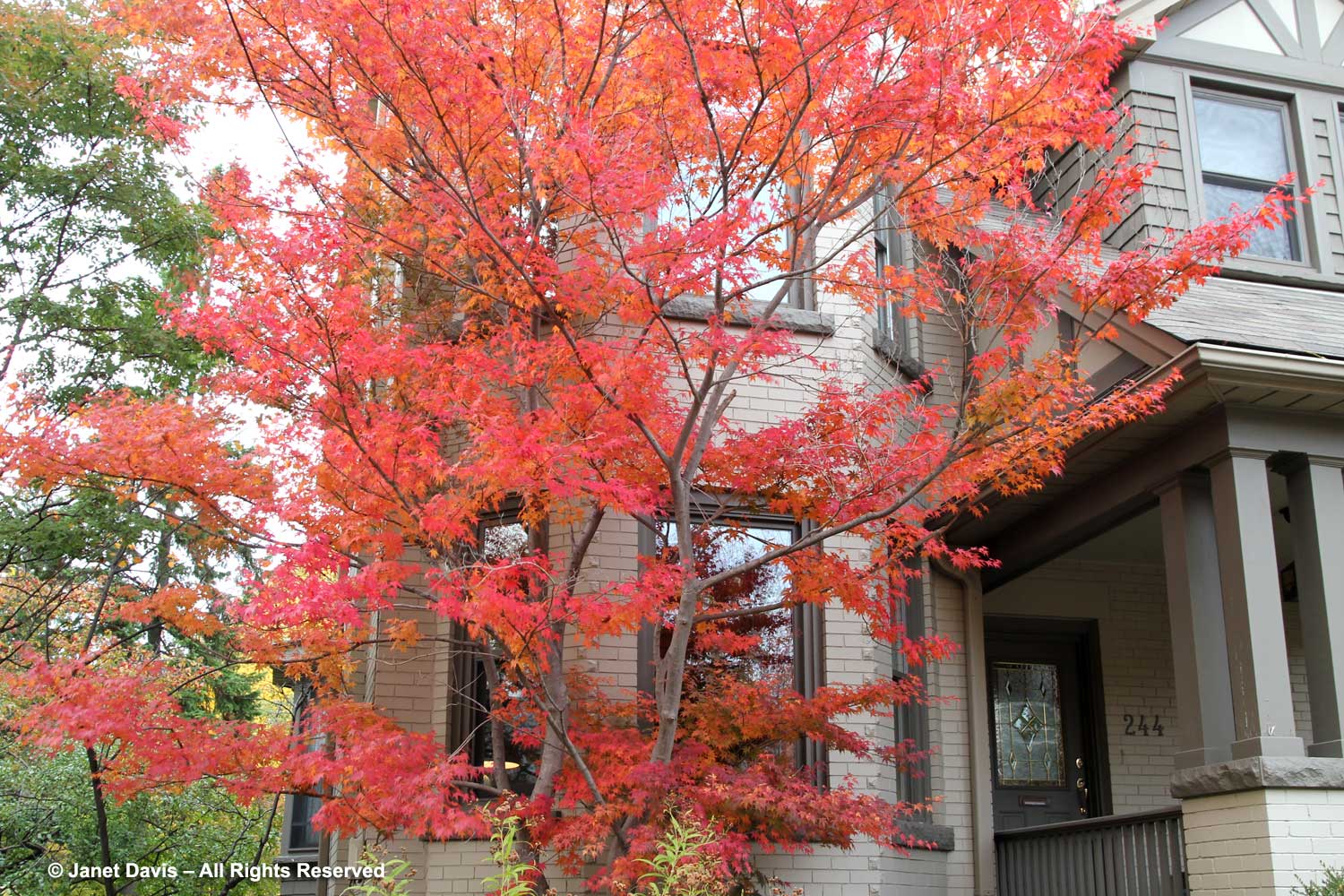
The leaves are delicate, their branching exquisite. It’s no wonder they were the subject of the renowned Japanese woodblock artists like Hiroshige and Kuniyoshi.
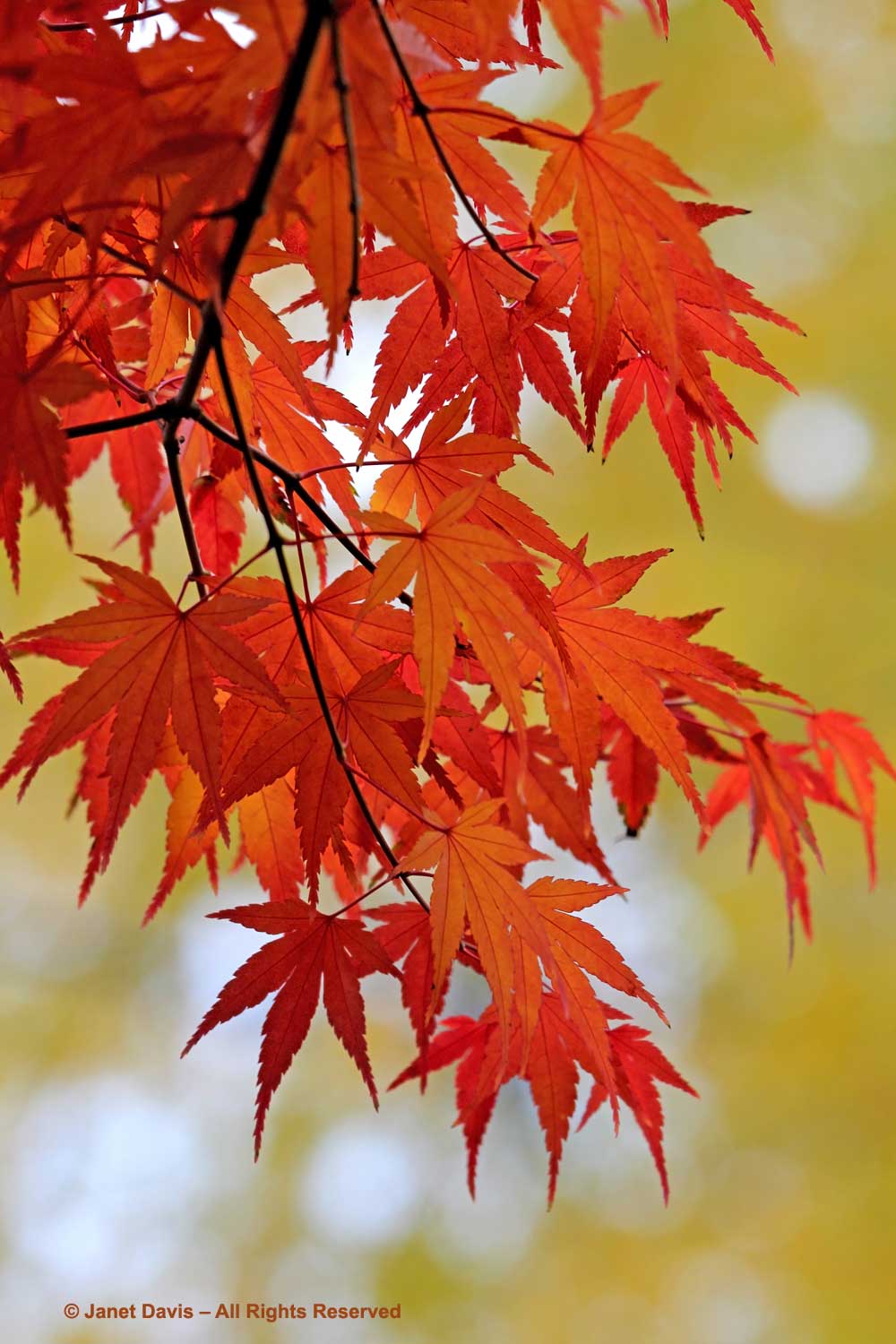
As I’ve written before, my Japanese maple’s brilliant autumn colour lights up my living room in early November….
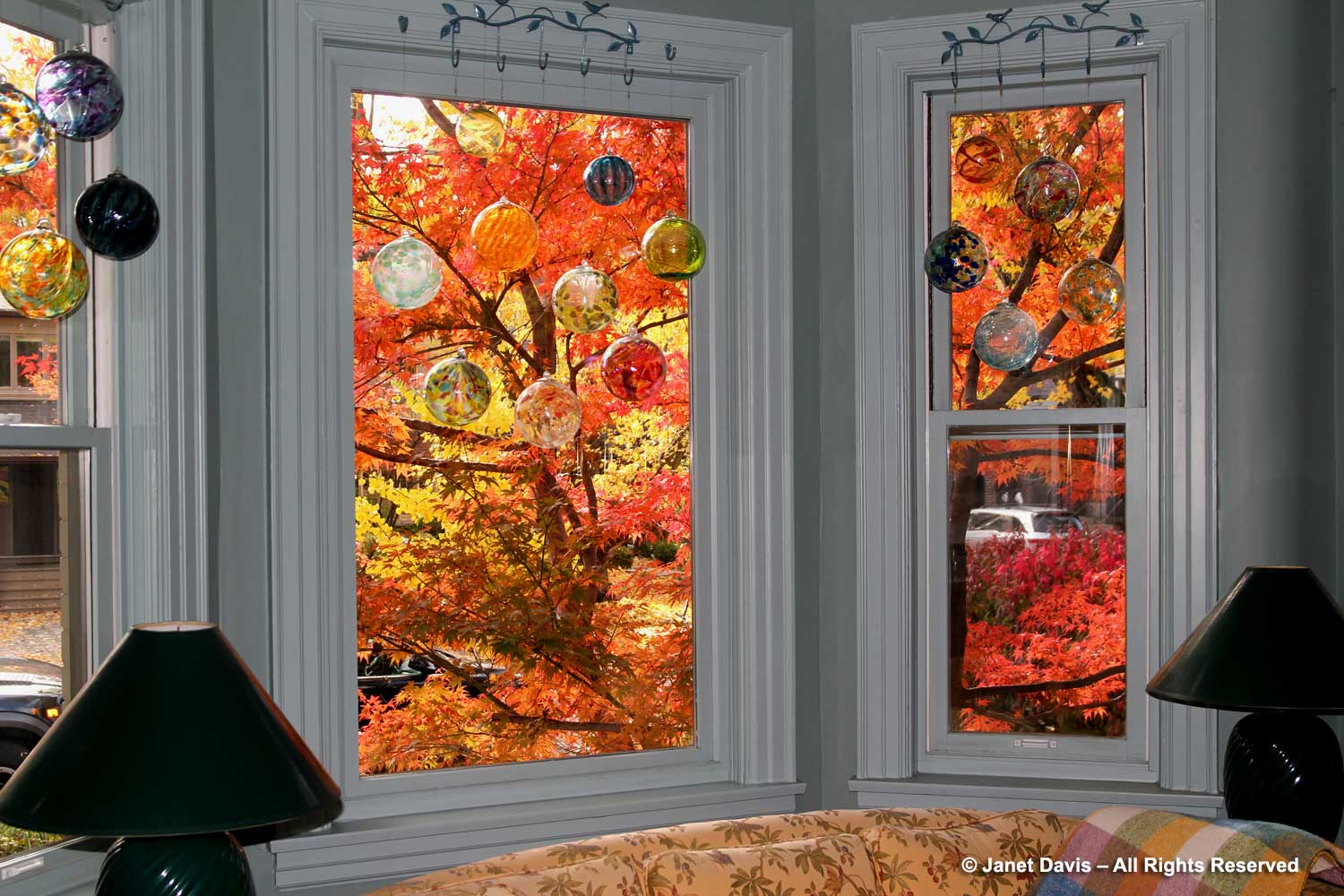
….. enhancing the glass witches’ balls I’ve suspended from the window frame.
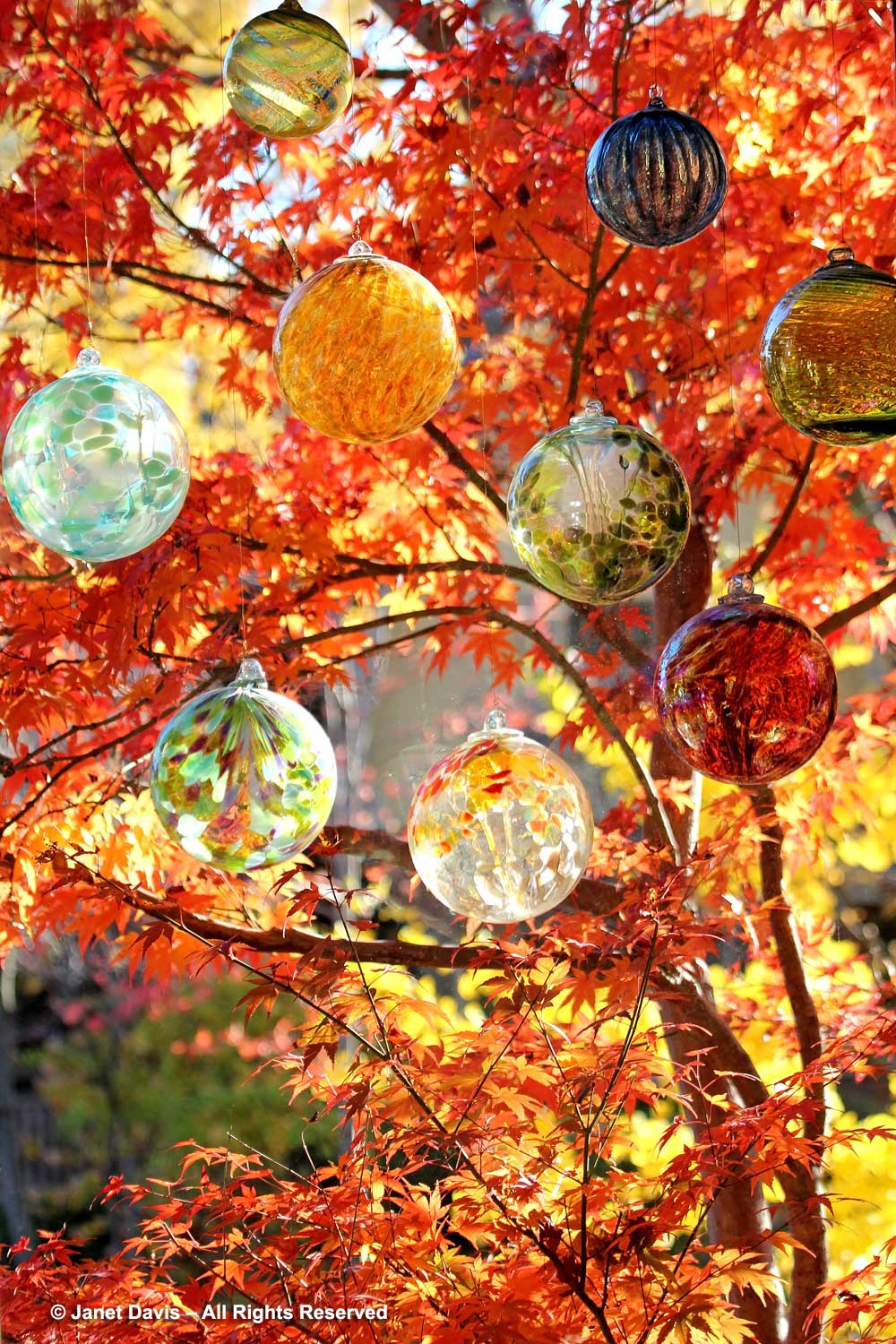
And, of course, the leaves also provided me with an appropriate costume and landscape for my little geisha.
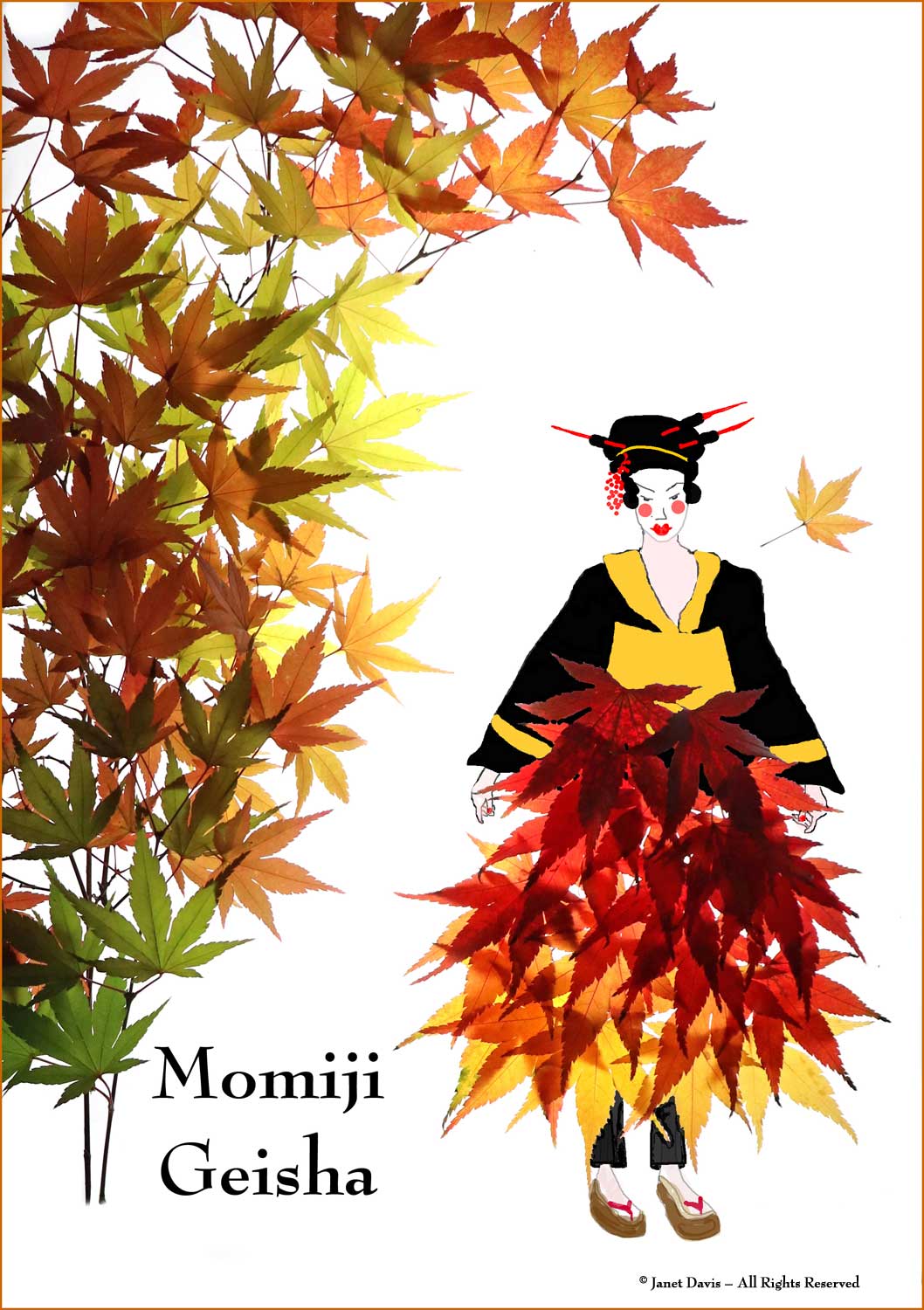
If there’s a saying that “good fences, good neighbours make”, it can also apply to hedges – which was how I ended up making this hedge in my front garden more than 30 years ago. (My current neighbours are lovely!) Today, environmentalists tend to shun burning bush, given its invasive tendency in milder regions, but my hedge produces very few seedlings, unlike the Norway maples in my neighbourhood which are a scourge. And this neon display in autumn is truly amazing.
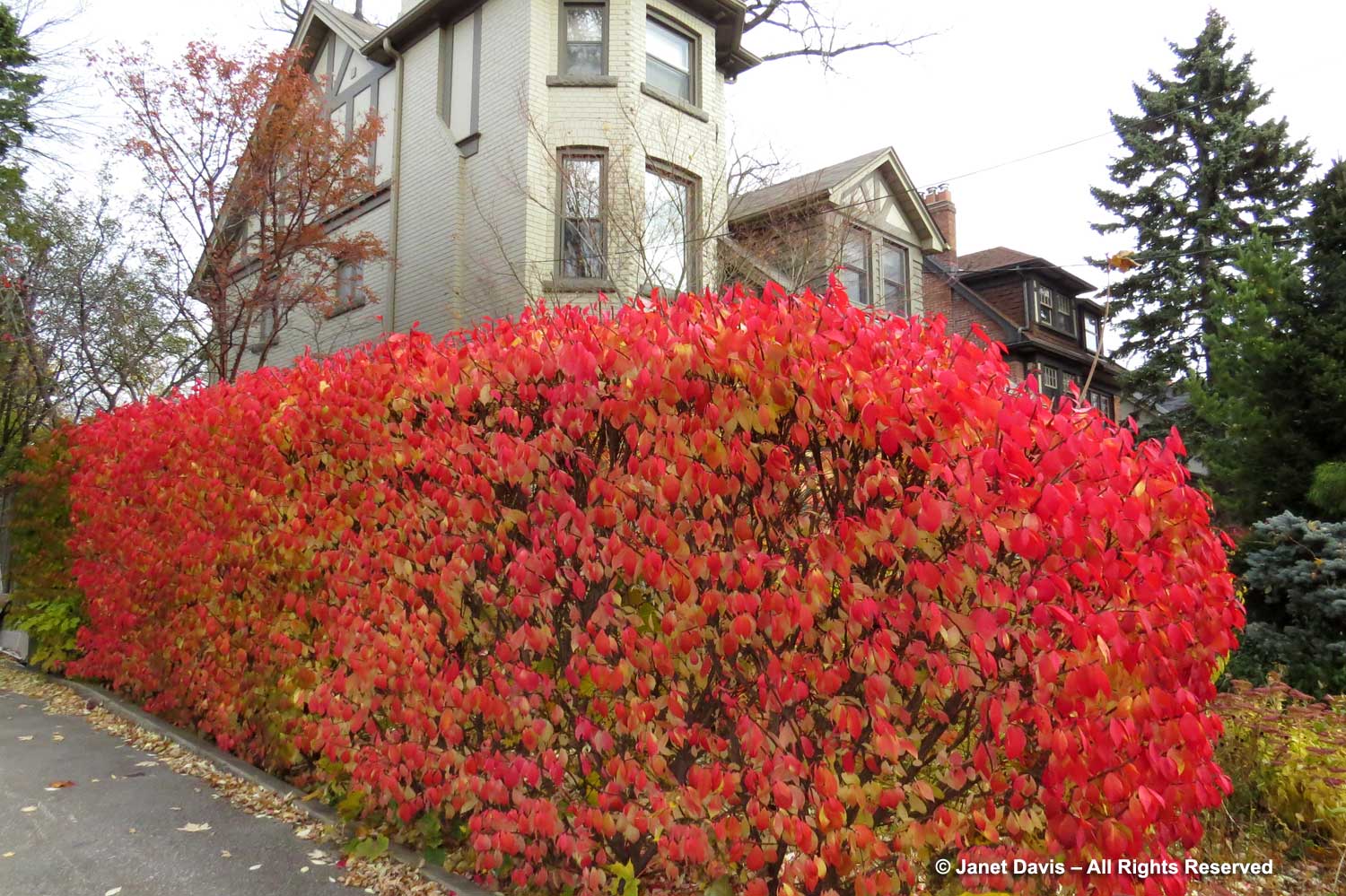
My belly dancer’s costume was made from the leaves of my burning bush hedge.
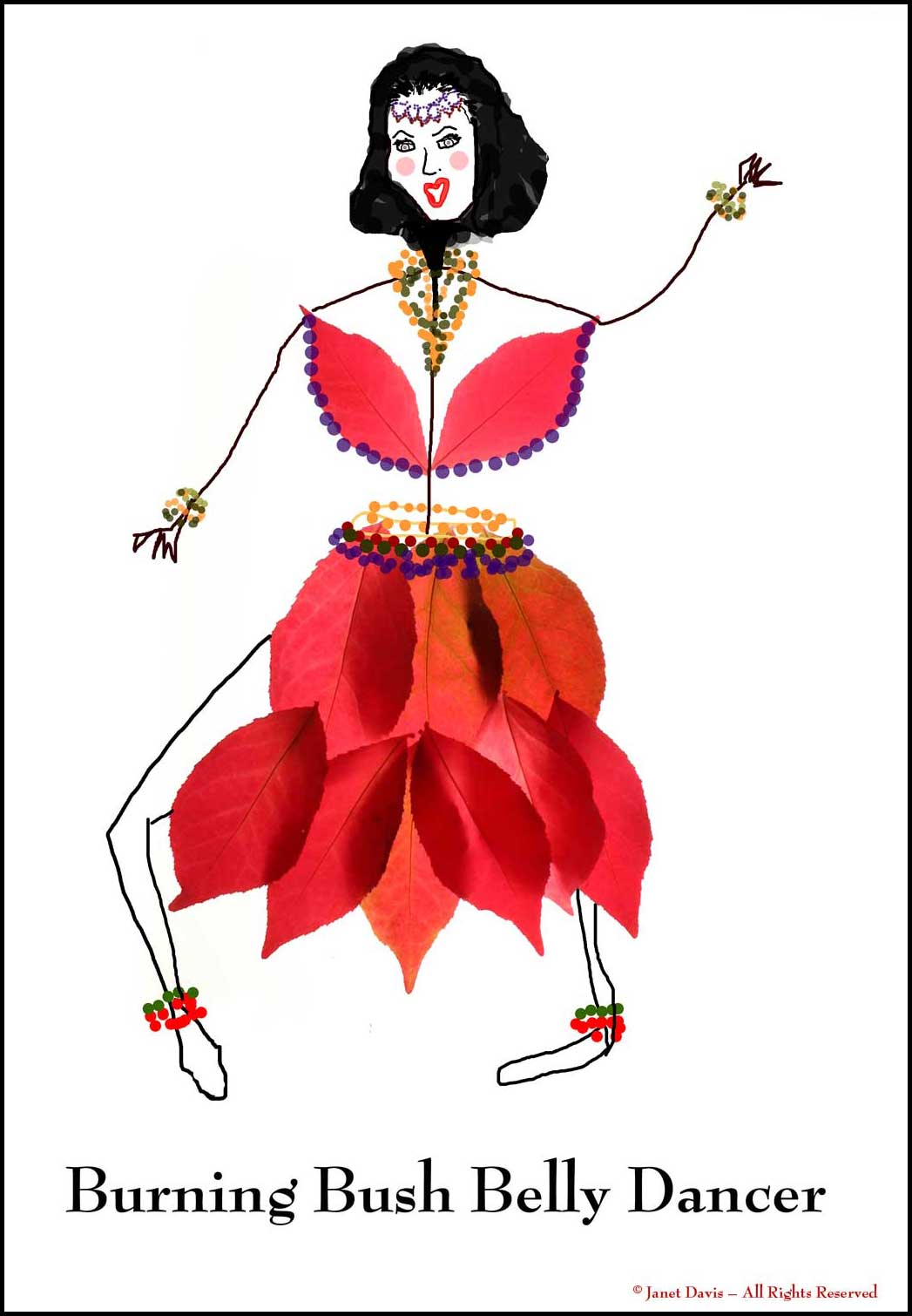
Though there’s no fothergilla in my crown, it is definitely a big part of the fall colour in my front garden. In this photo made just before Halloween, you can see one of my shrubs has turned a rich burgundy-red beneath the Japanese maple.
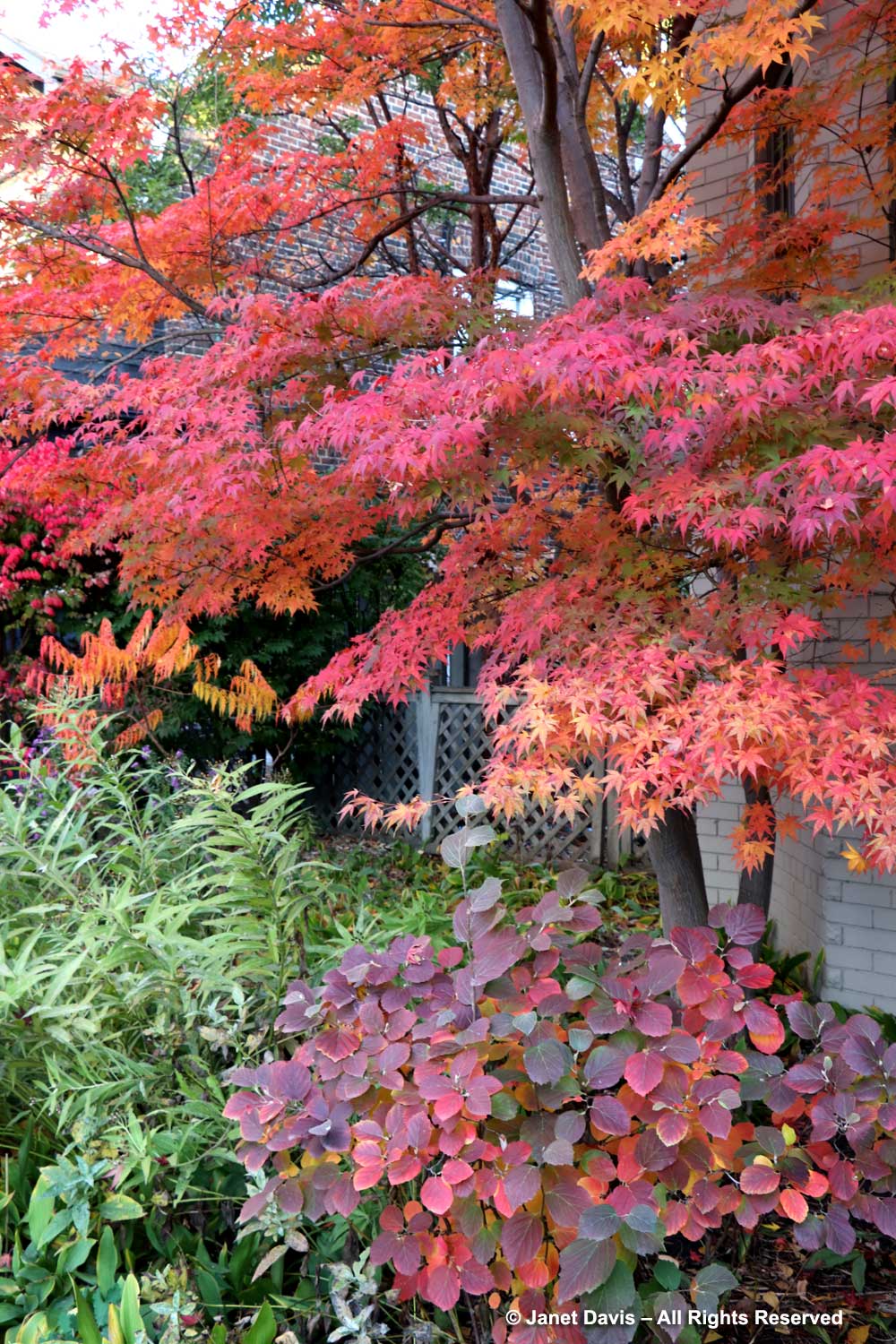
The richer, more moisture-retentive soil in my pollinator island tends to produce orange and gold colours in the three fothergilla shrubs there.
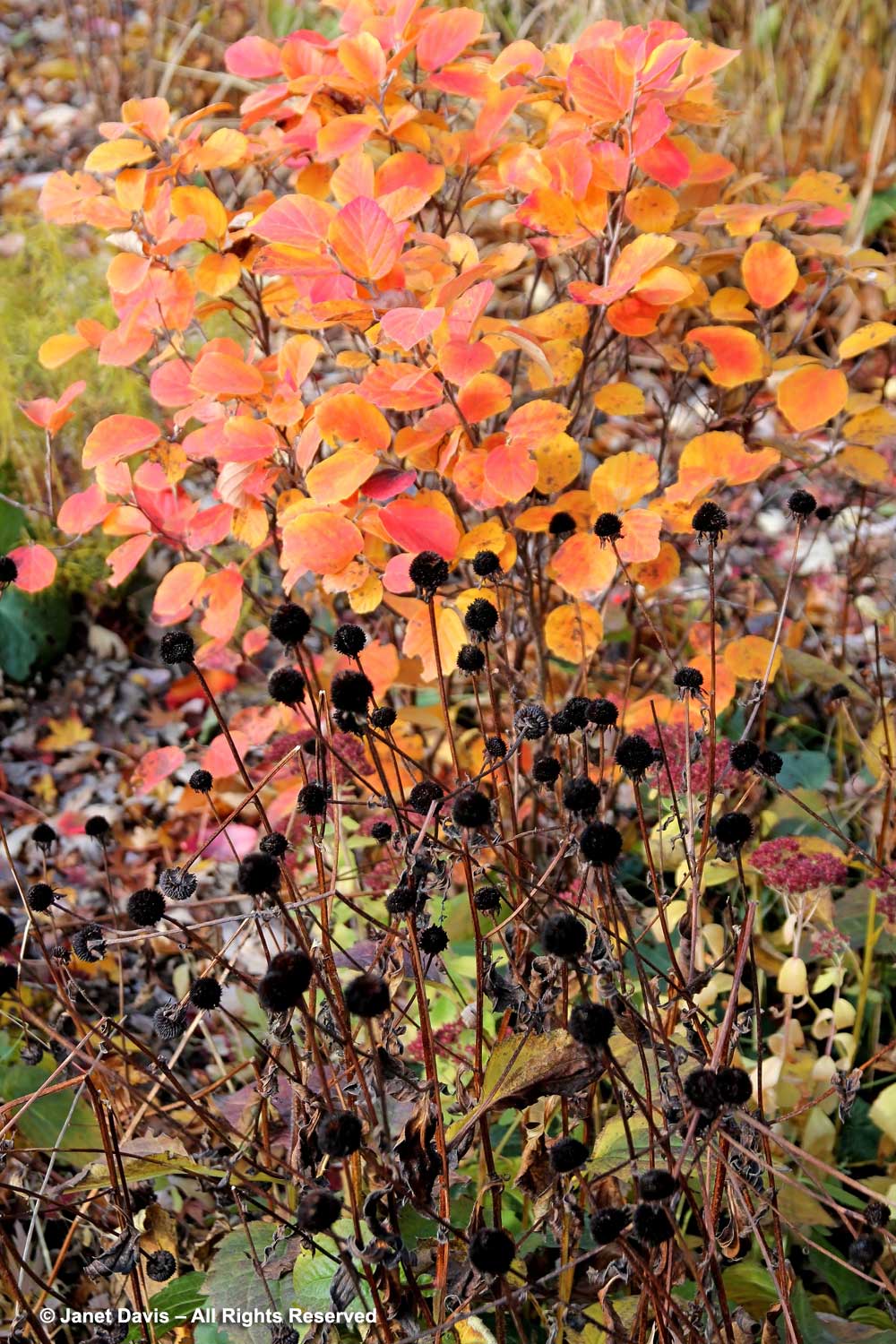
Look at those colours! Who needs the spring flowers….
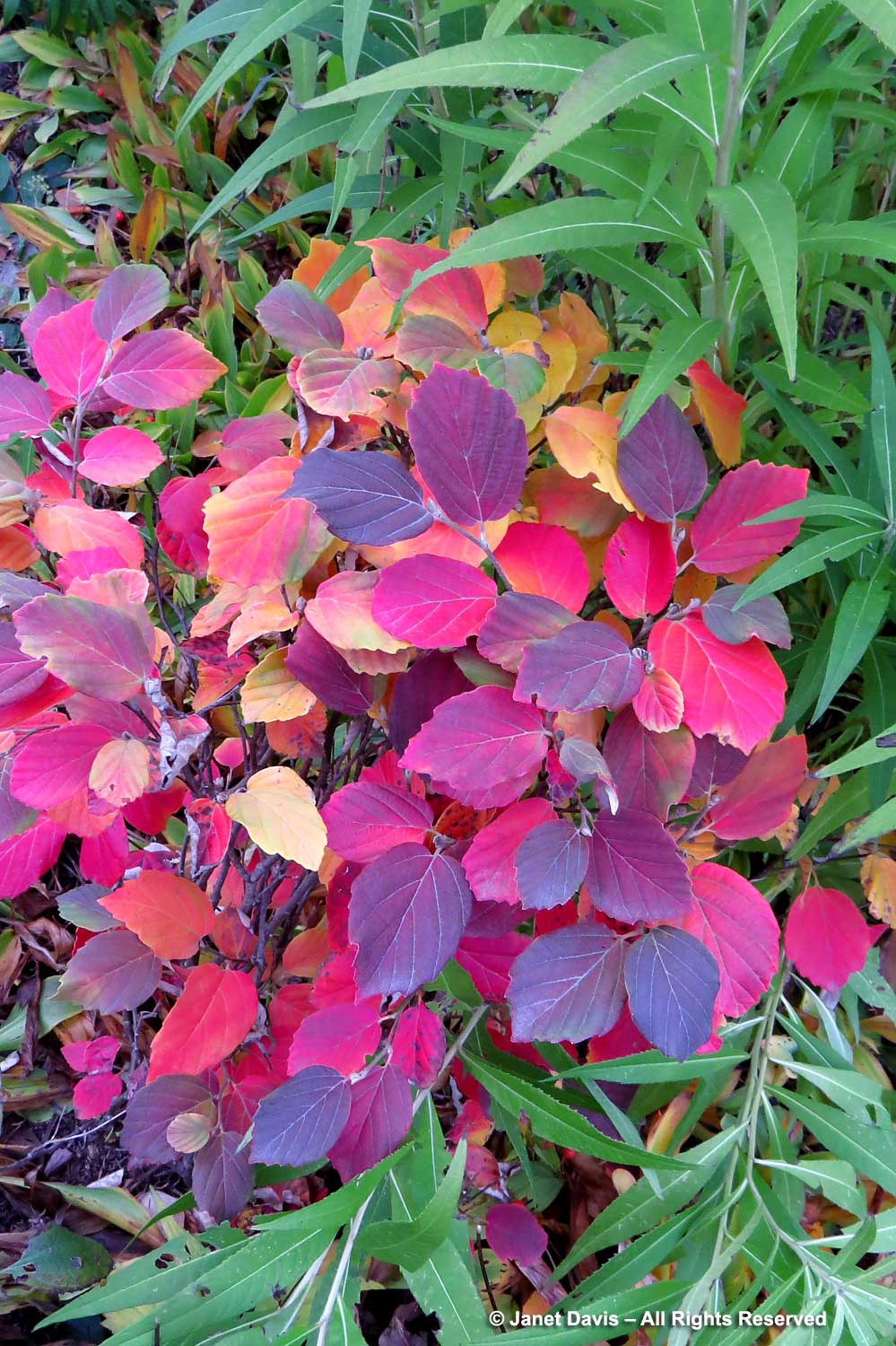
…. though they are lovely, if short-lived, in late May.
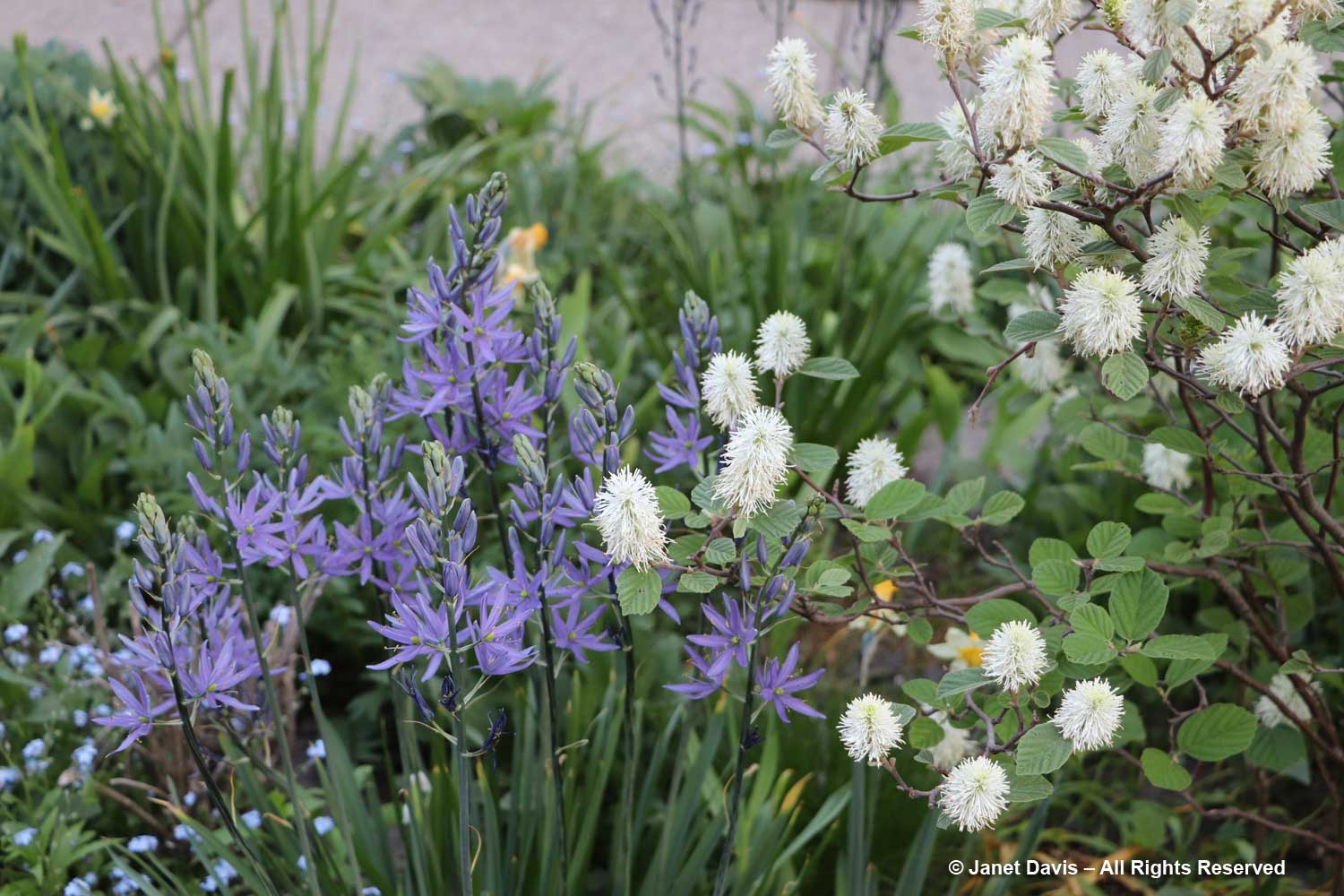
And, yes, I did harvest my flamenco dancer’s multi-colored skirt from my fothergillas.
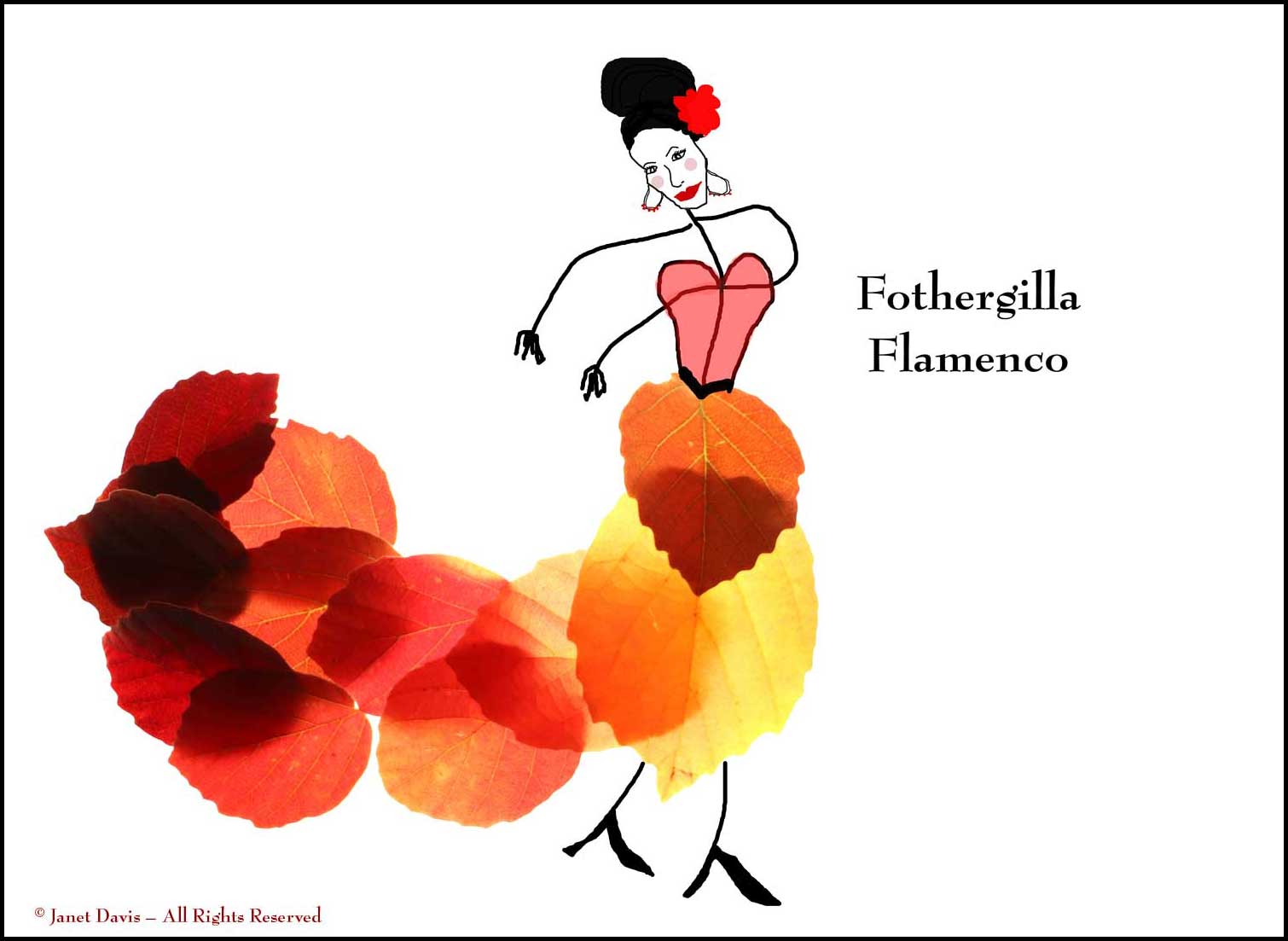
Turning colour a little later in the front garden is my paperbark maple (Acer griseum) with its red trifoliate leaves.
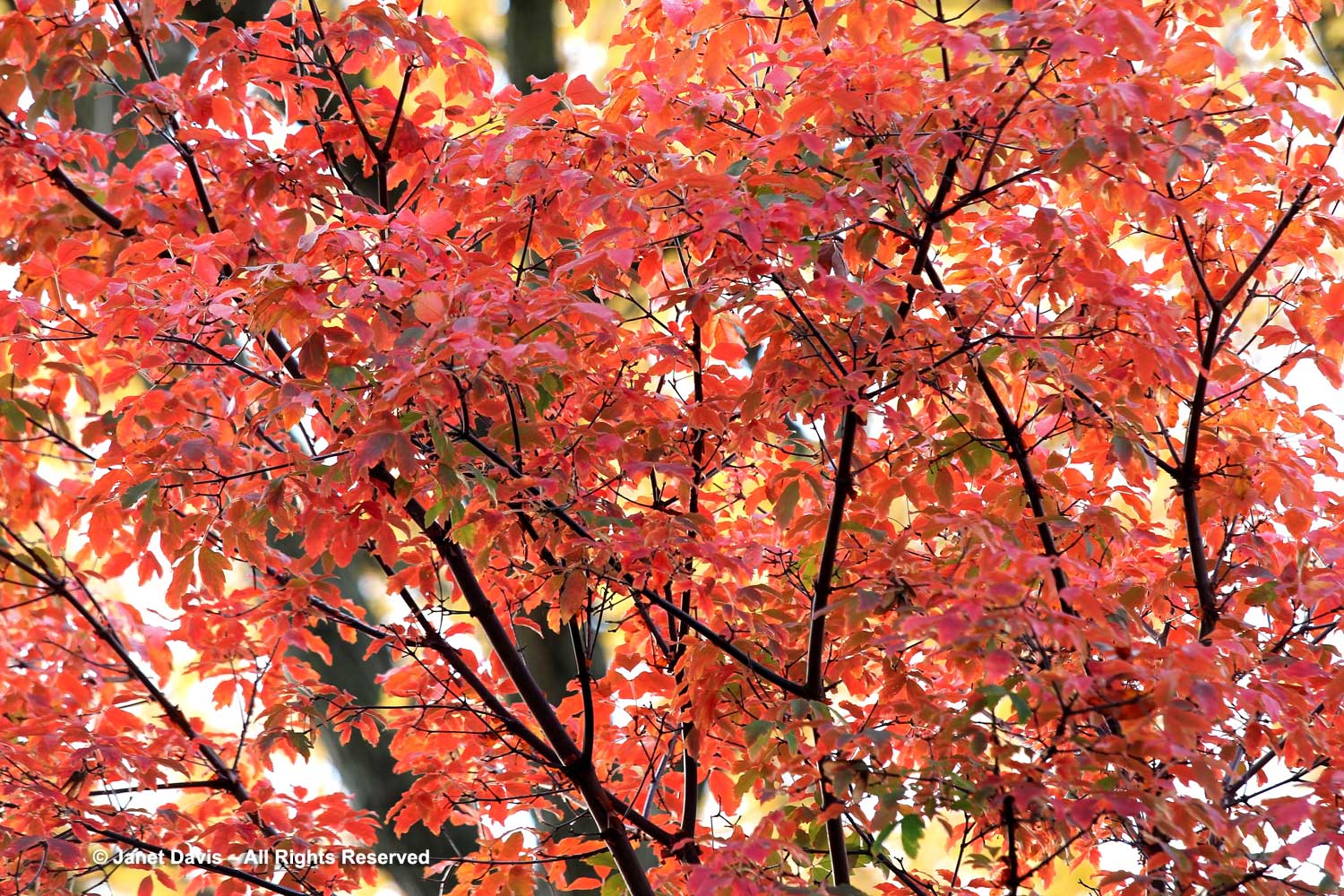
Moving into the back garden, you see Boston ivy (Parthenocissus tricuspidata) cloaking the driveway gate. I didn’t plant this vine, nor did I plant all the Virginia creeper vines that pop up throughout the garden. That’s Mother Nature’s role and she’s very enthusiastic about it (!)
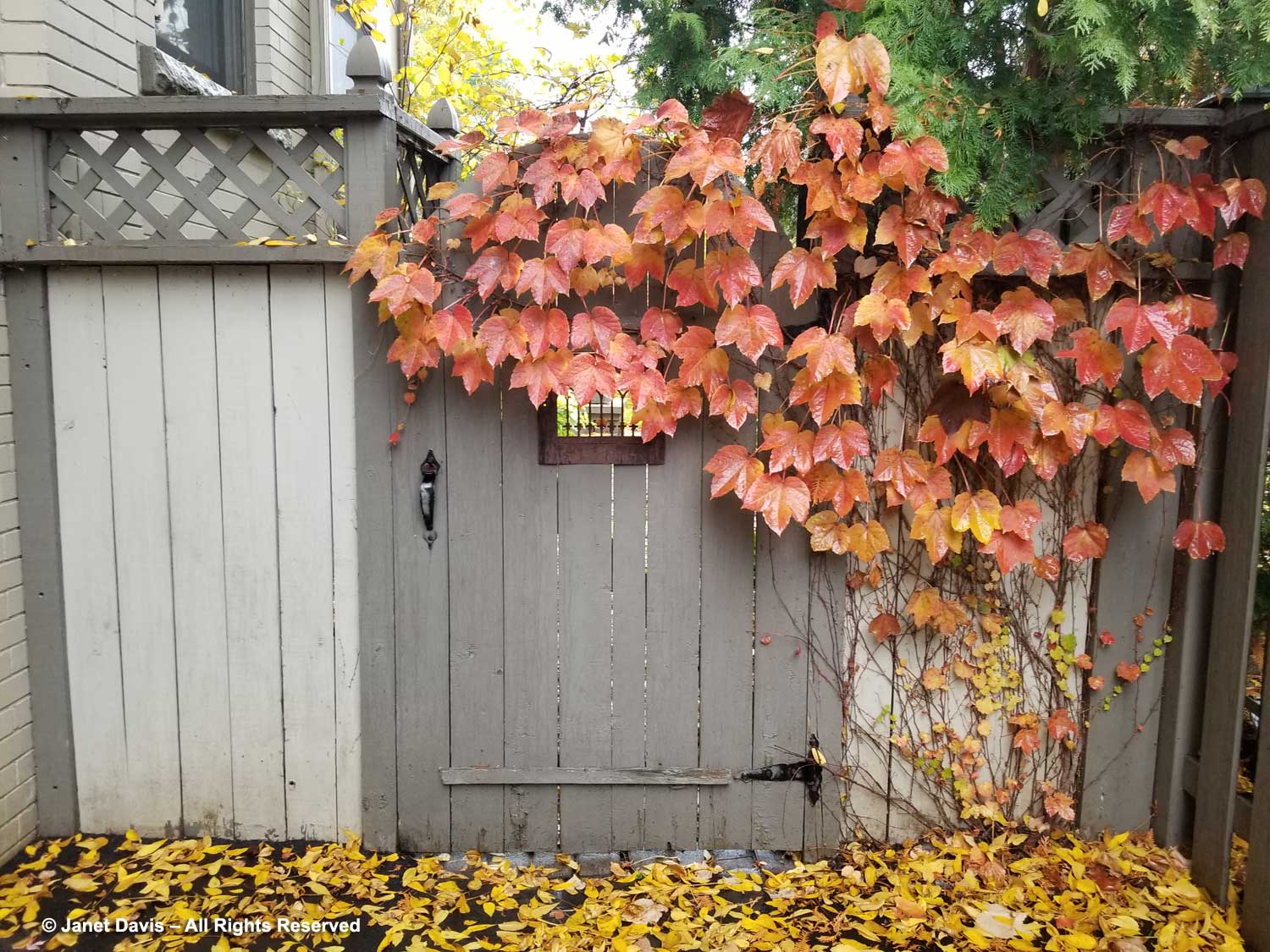
I confess that I wanted the Washington thorn tree (Crataegus phaenopyrum) in my garden long ago purely for its multi-hued fall leaves.
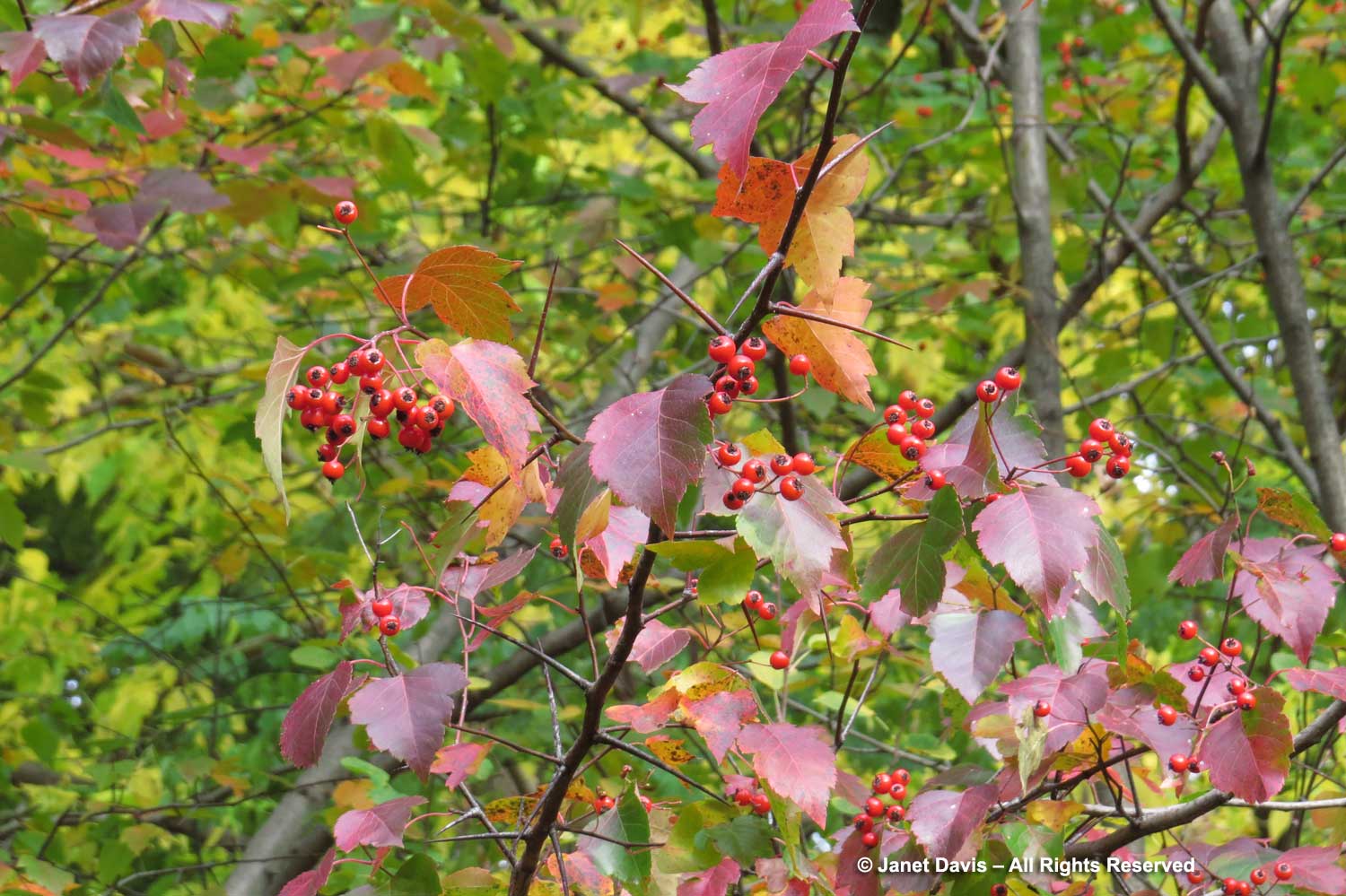
But it turned out to be a wonderful tree for bird life – IF the birds can out-compete the squirrels for the fruit. The robin, below, managed to do that, but so have cedar waxwings and cardinals.
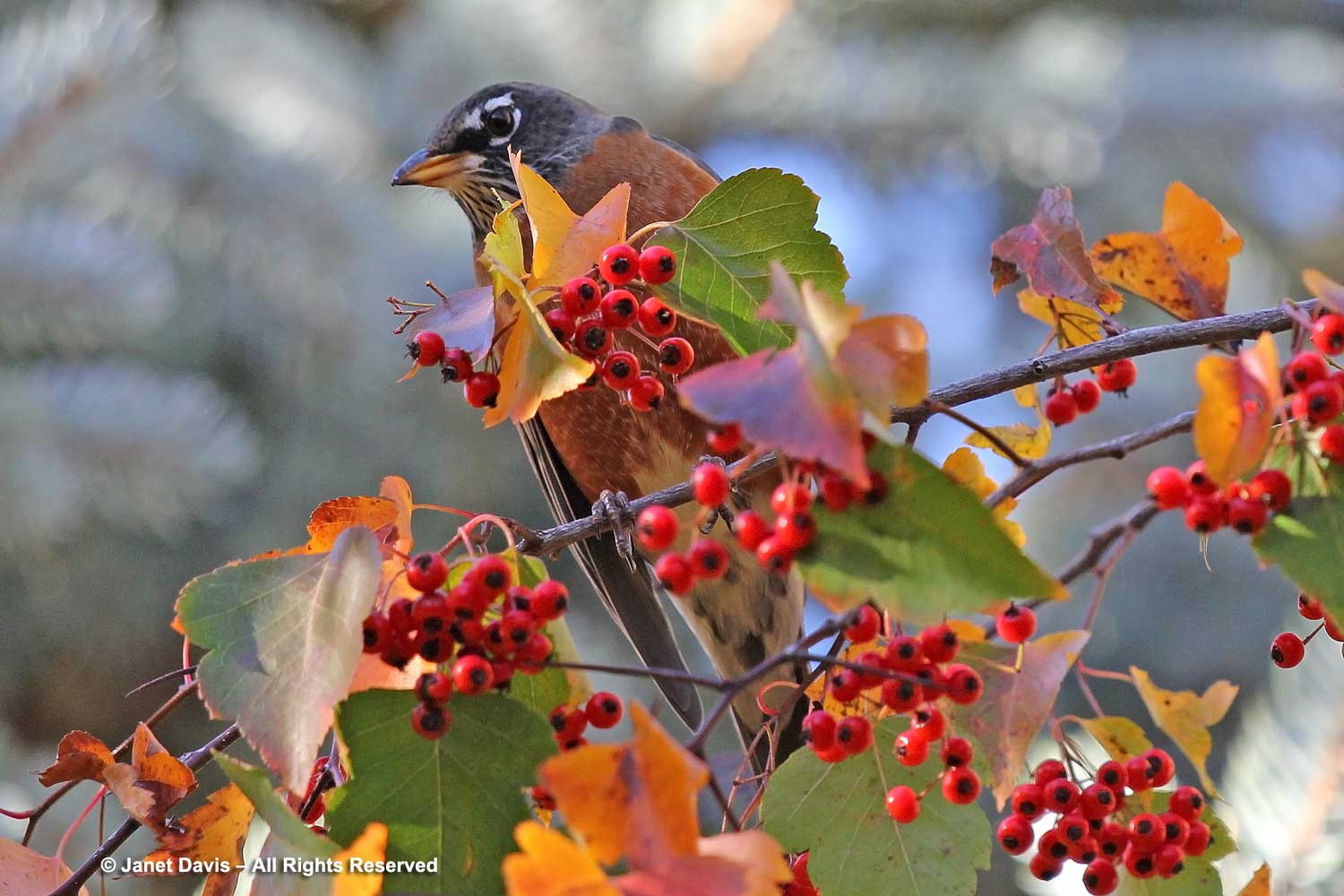
Here you can see the range of autumn colour in the foliage of Washington thorn.
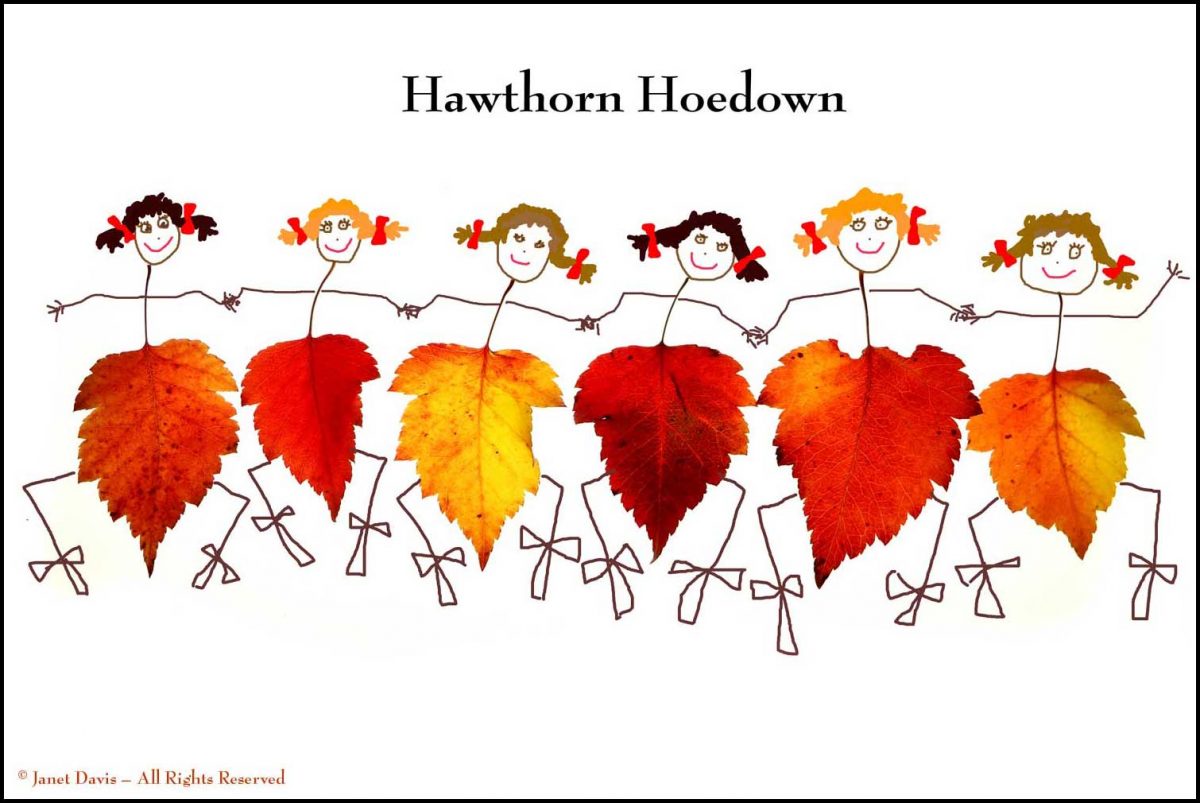
When we bought our house in 1983, the native black walnut tree (Juglans nigra) on the property line between us and our next-door neighbour was already mature. In the 39 years since then, it has hosted raccoon families in the crook of its trunk, carpenter ants in its bark and countless cardinals practising their song in its branches.
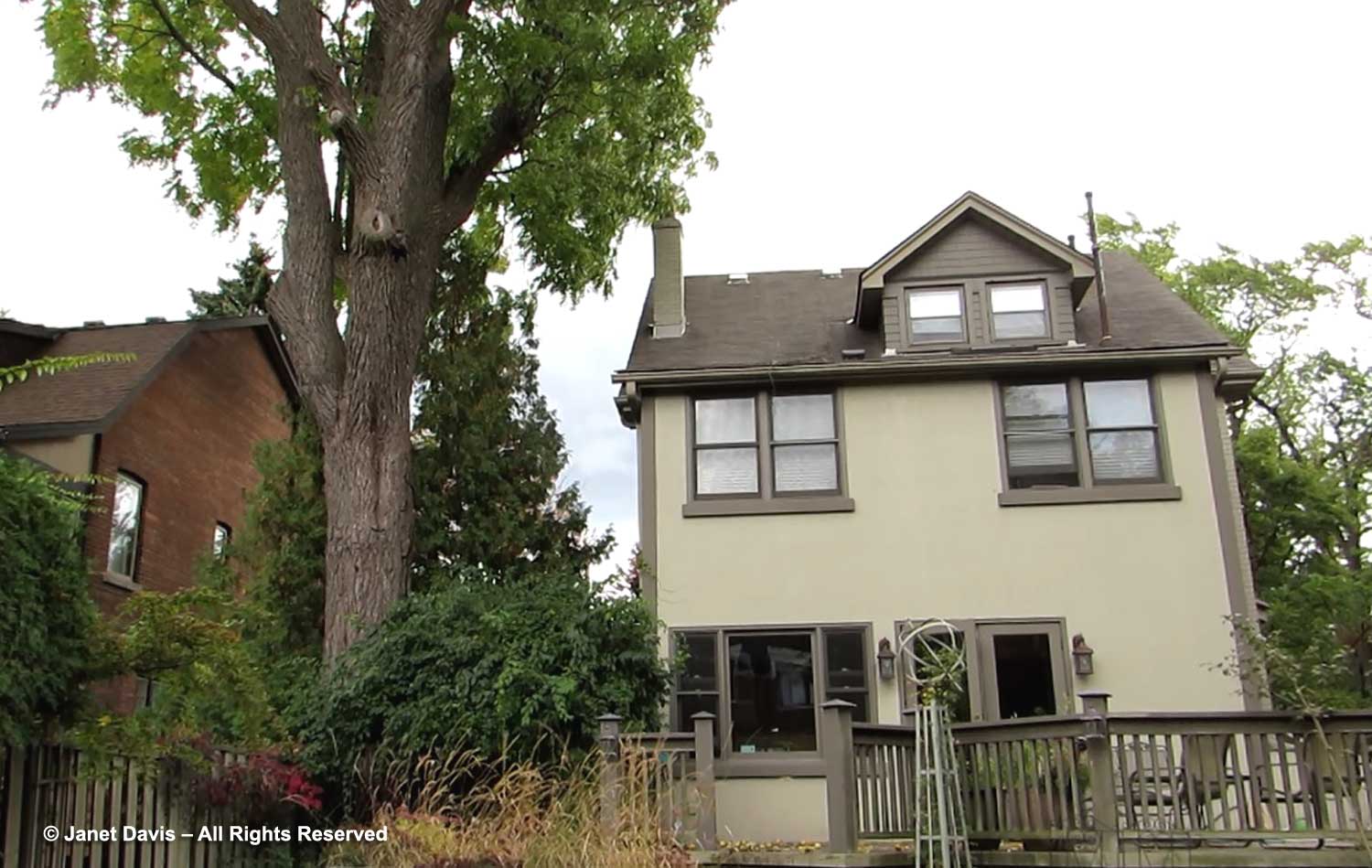
Our bedroom sits right under the tree, but we seemed to have missed the obvious ramifications of putting a skylight in our ceiling – particularly when windy nights in September roll around and the roof is pummelled with billiard-ball-sized nuts. Though the skylight has proven strong, we’ve replaced two car windshields since the tree’s branches — and nuts — extend far over the driveway.
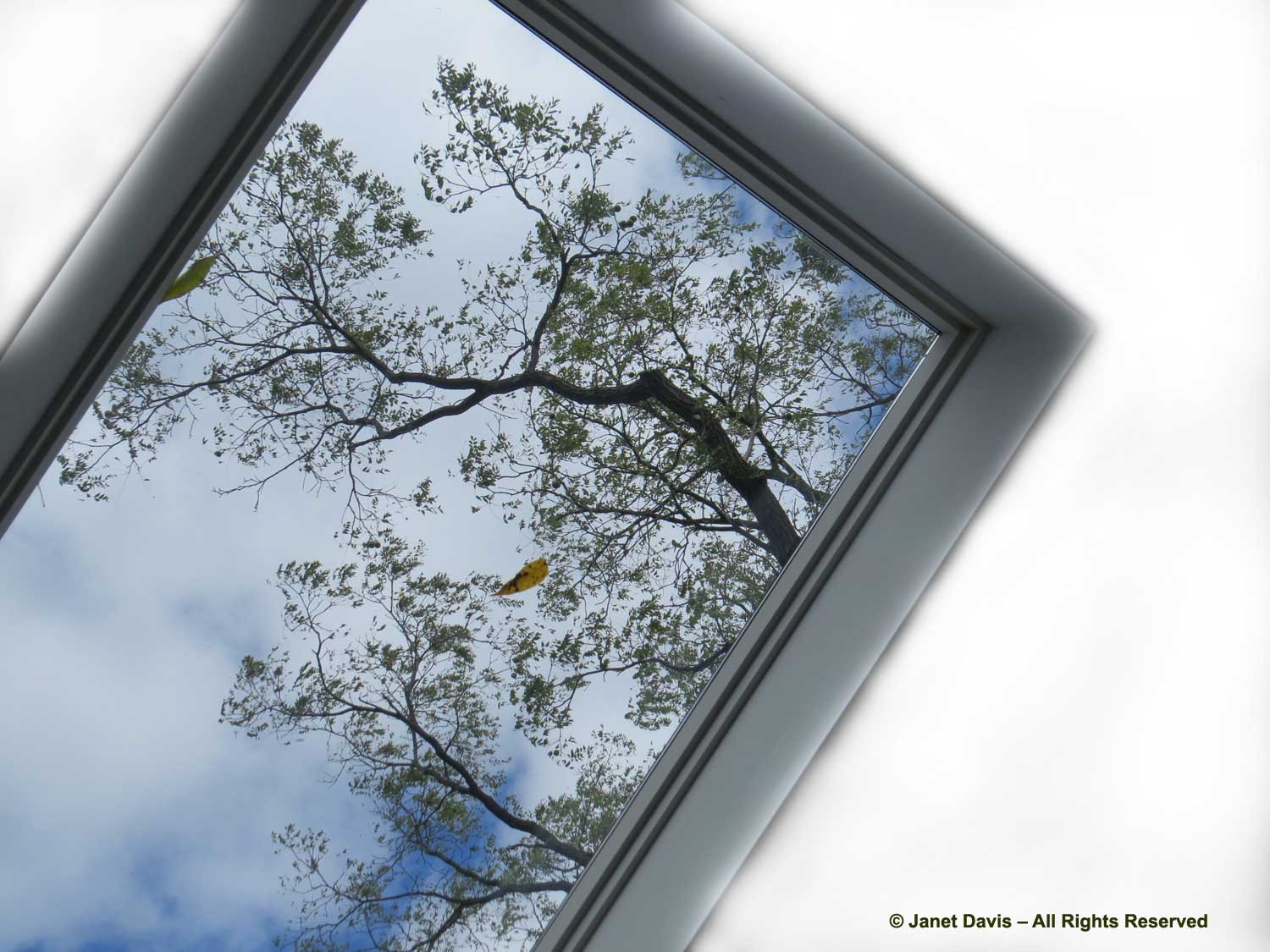
The walnuts are enjoyed by the neighbourhood squirrels….
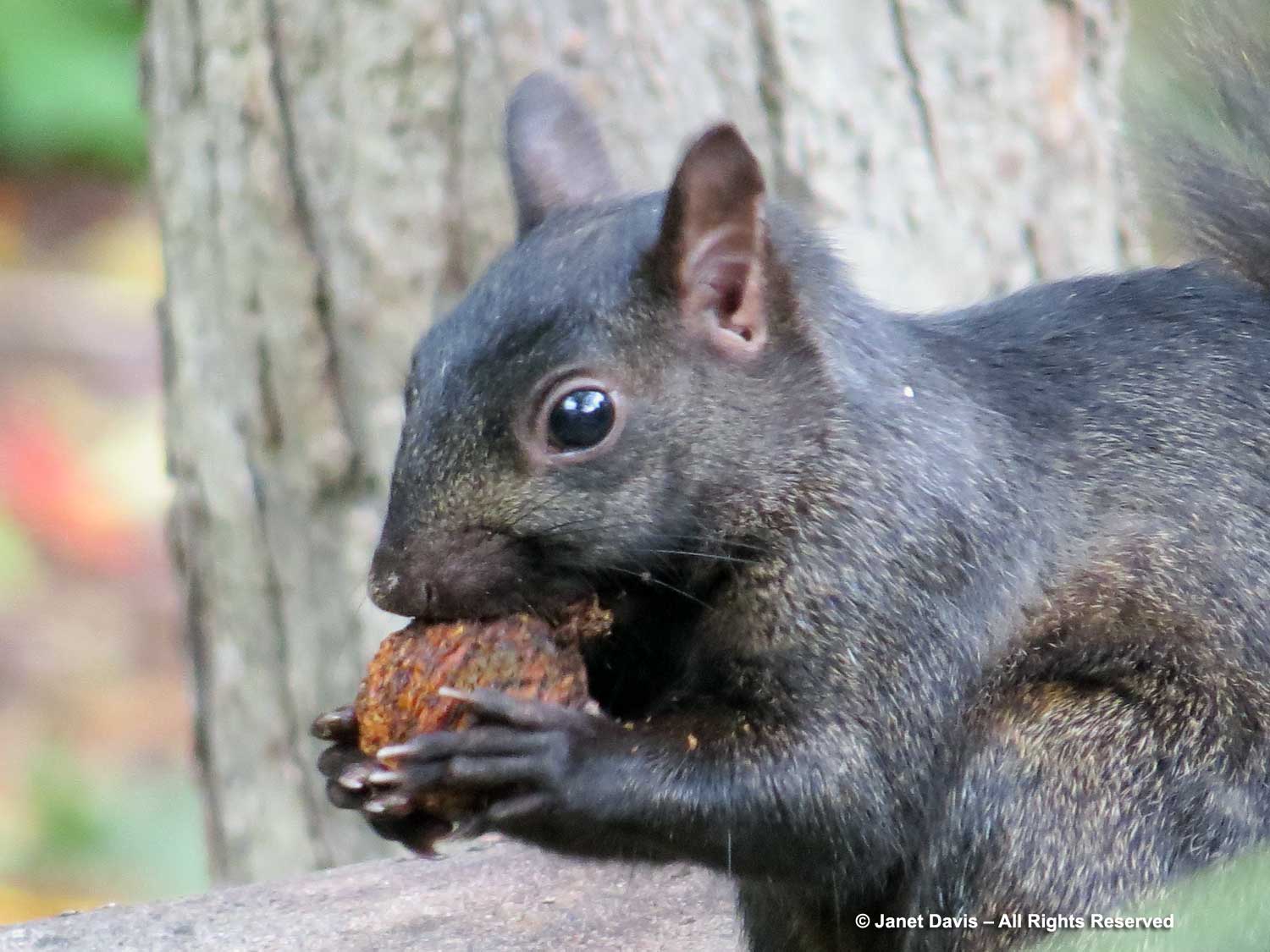
….. but the natural dye in the husks creates an unbelievable mess.
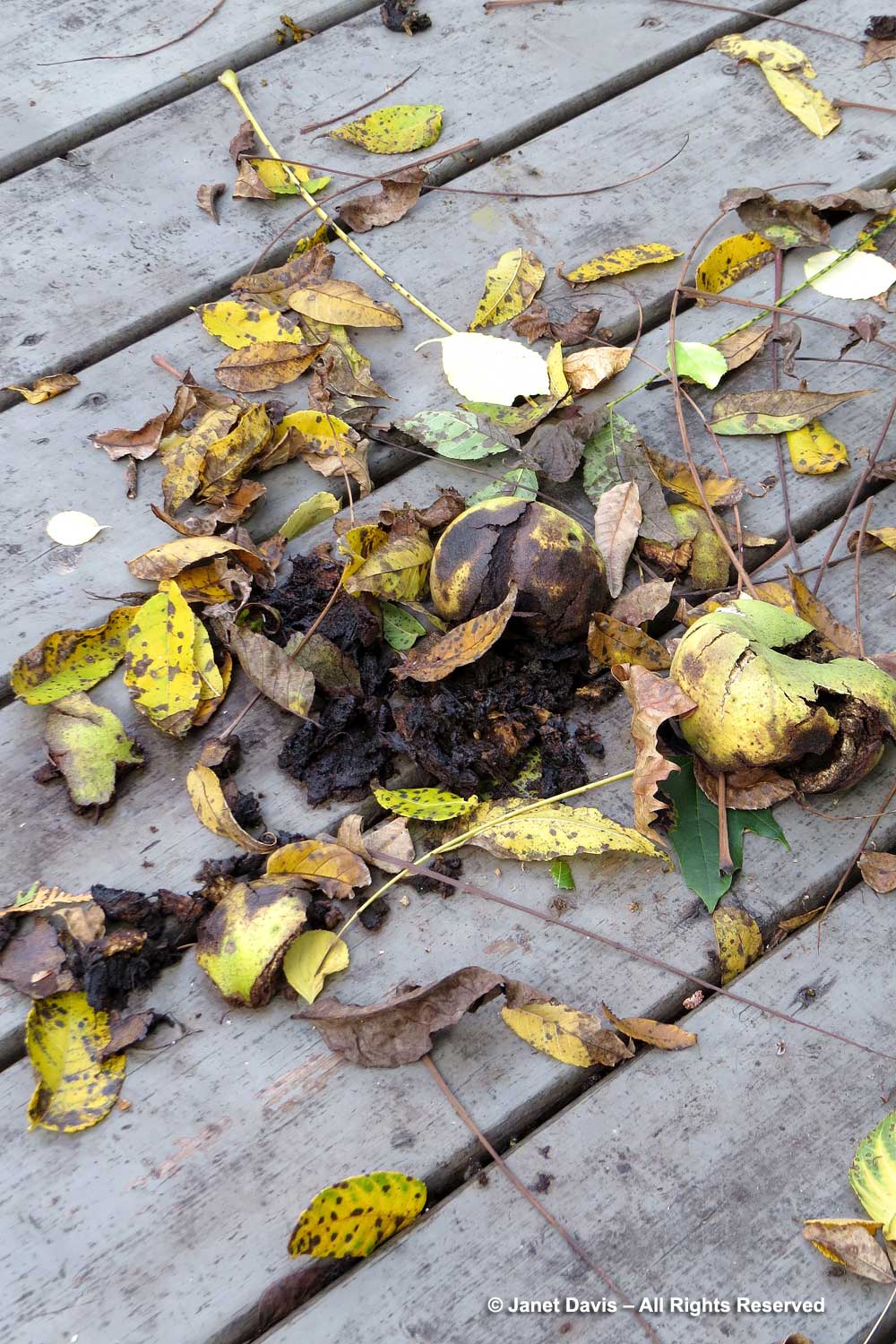
The arborist has told us the tree has rot in the trunk, but my neighbour and I have had it cabled and pruned away some of the branches over our houses to reduce the nut fusillade. It is our tree, after all, it gives us shade and we feel a duty to keep it – thus its inclusion in my 26th crown.
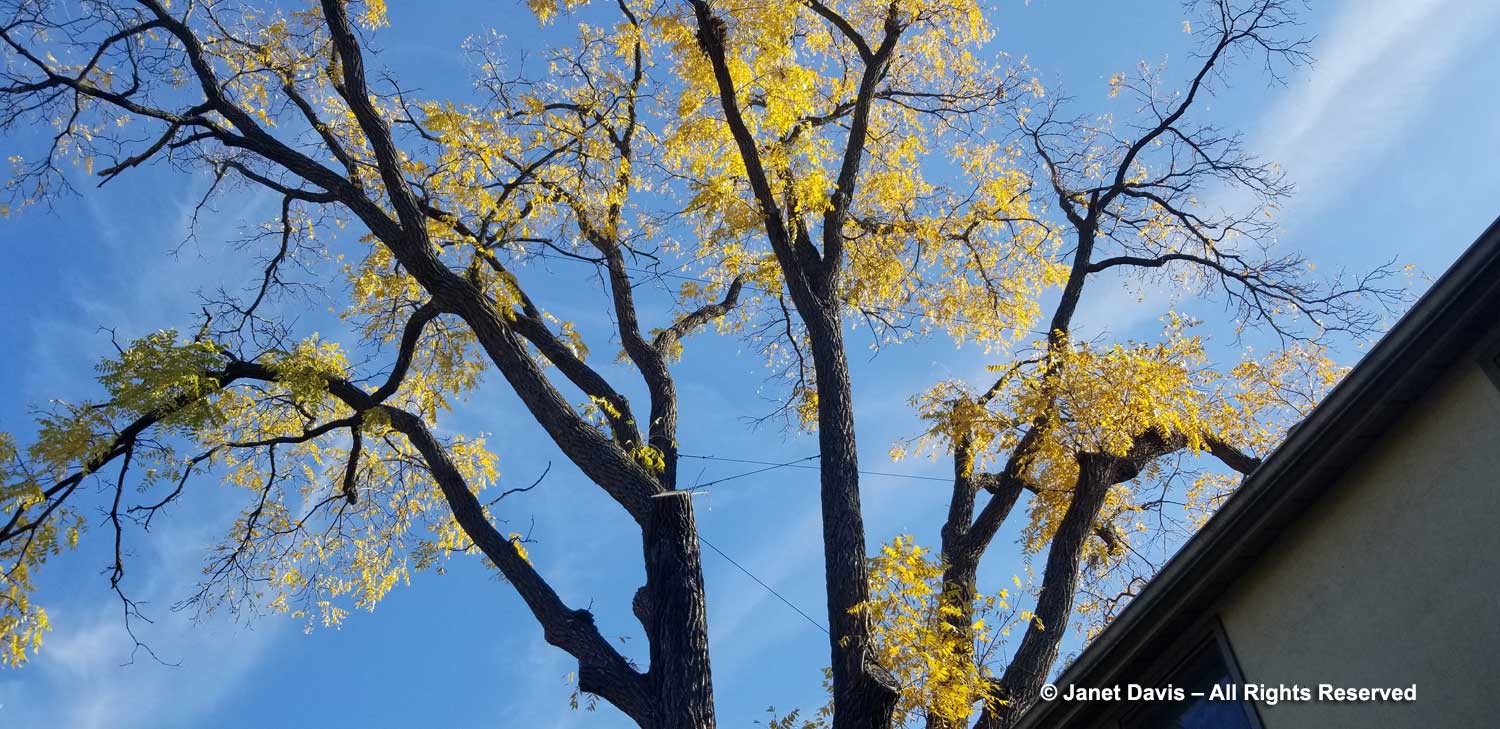
I don’t really notice the ‘Rose Glow’ barberry (Berberis thunbergii) in my back garden until it turns rich crimson-red in autumn – then it’s a show-stopper. It’s another one of those shrubs that environmentalists shun – especially in milder U.S. regions where it seeds around freely. I haven’t seen one seedling in my Toronto garden.
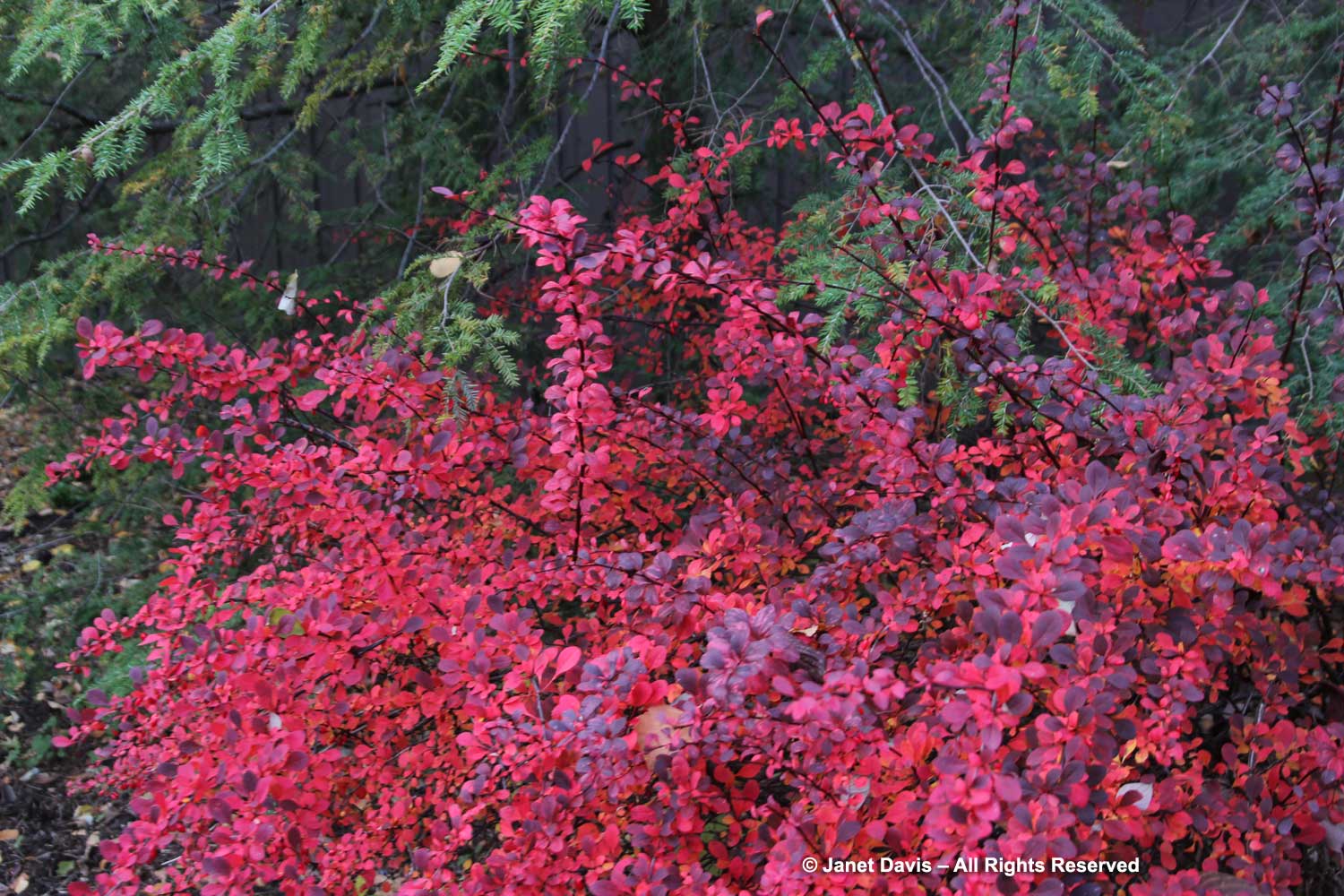
I have a fairly new addition to my back garden: a little sassafras tree (S. albidum). which I wanted especially for its fall colour. This autumn – admittedly one of the best for colour in many years – it has begun to display the reds, corals and yellows for which it is known.
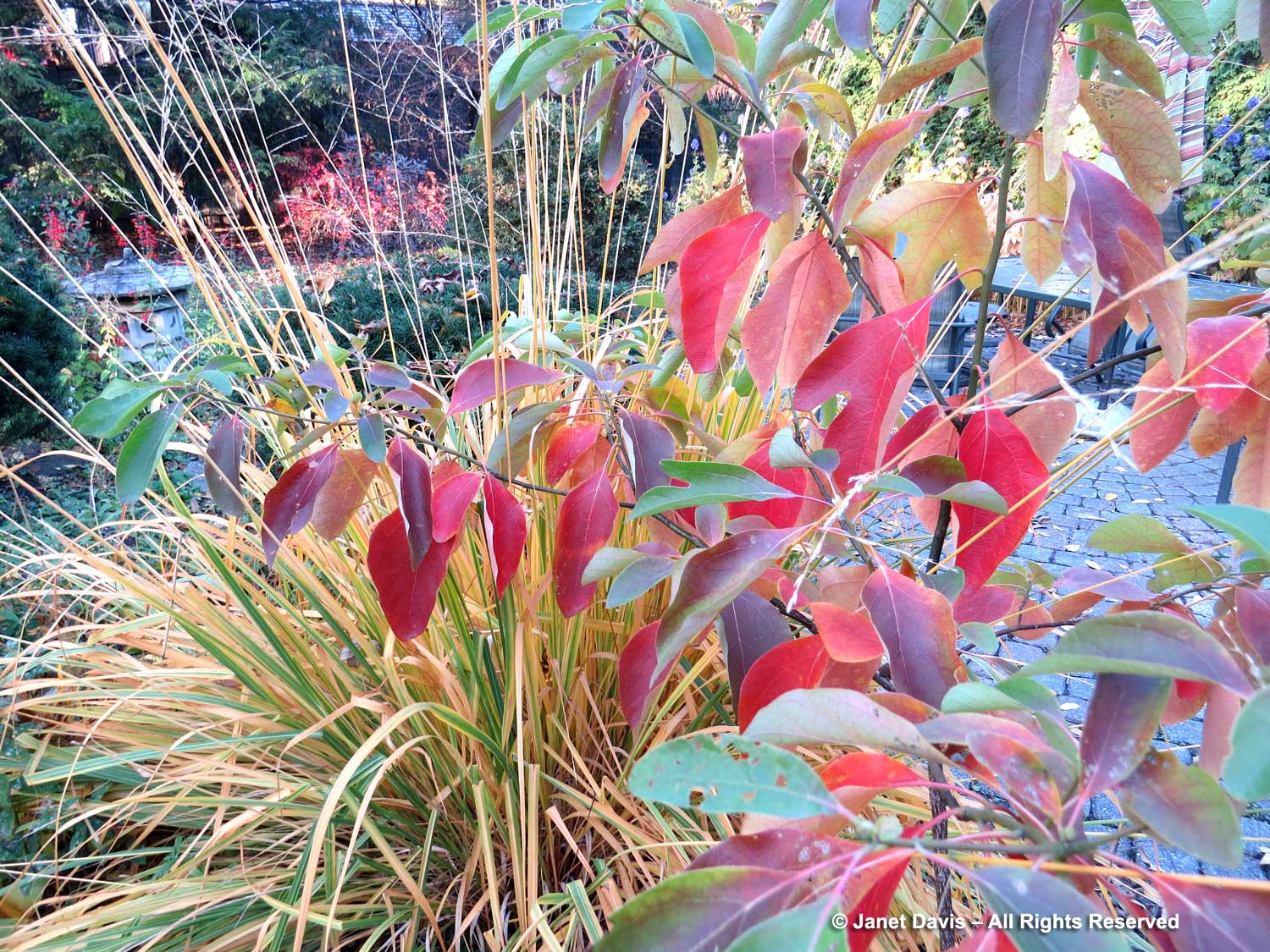
Those colours, by the way, are on leaves that exhibit three distinct shapes: elliptical; mitten-like and three-lobed. This is what they look like on my light table.
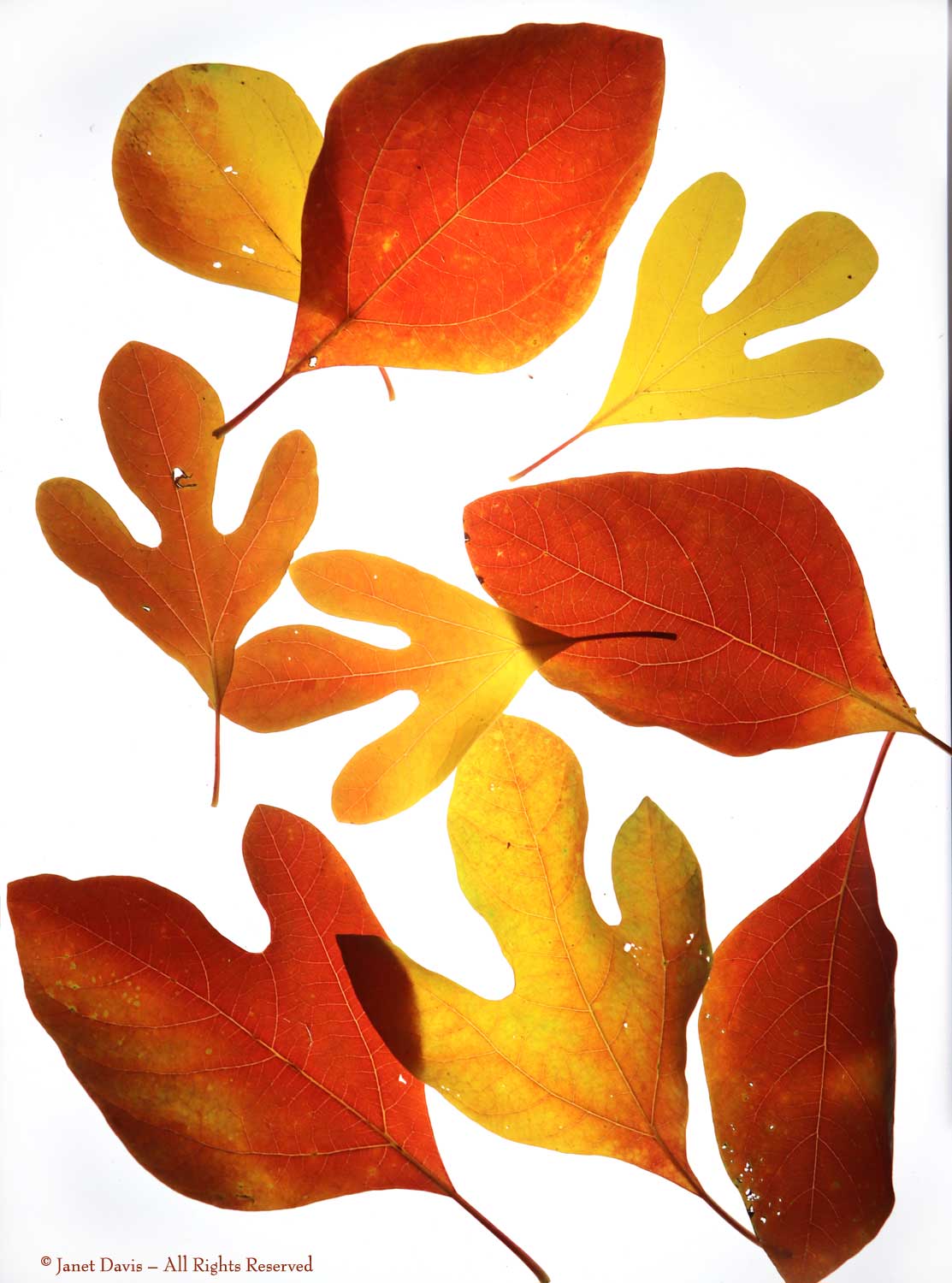
Designing with and celebrating fall-colored plants and shrubs is my way of expressing my appreciation for nature’s yearly preparation for winter, as it cycles through the yellow/orange “accessory” carotene pigments in the leaves of certain species to harvest and synthesize as much sunshine as possible, once the ‘green’ pigment chlorophyll breaks down in cooler temperatures. Red colour is from anthocynanis. According to the USDA, “Anthocyanins absorb blue, blue-green, and green light. Therefore, the light reflected by leaves containing anthocyanins appears red. Unlike chlorophyll and carotene, anthocyanins are not attached to cell membranes, but are dissolved in the cell sap. The color produced by these pigments is sensitive to the pH of the cell sap. If the sap is quite acidic, the pigments impart a bright red color; if the sap is less acidic, its color is more purple. Anthocyanin pigments are responsible for the red skin of ripe apples and the purple of ripe grapes. A reaction between sugars and certain proteins in cell sap forms anthocyanins. This reaction does not occur until the sugar concentration in the sap is quite high.” Because the reaction requires light, you often see leaves (or apples) fully exposed to sun that are red while those parts that are shaded stay green or yellow, like these Boston ivy leaves on my fence.
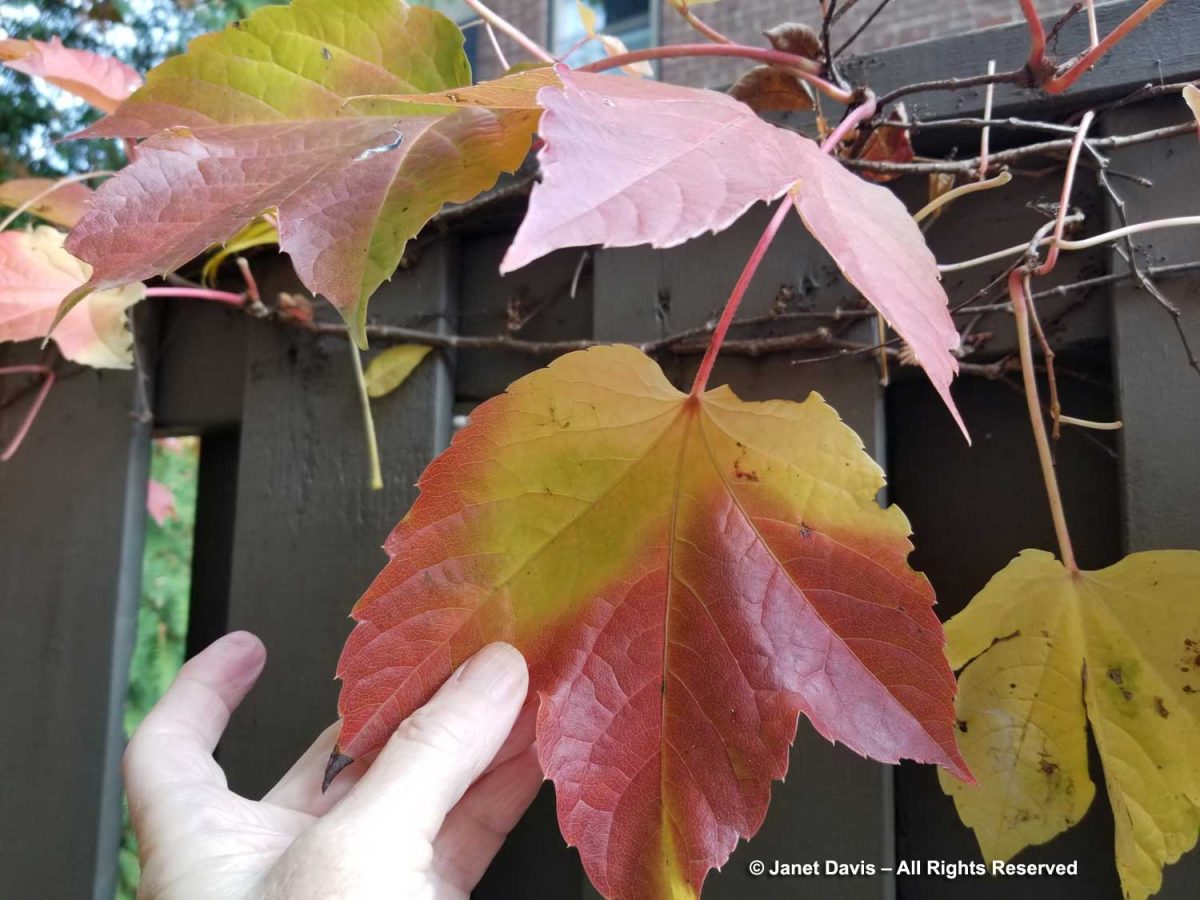
I love making the leaf montages that celebrate these pigment changes, like the one below from leaves in my garden.
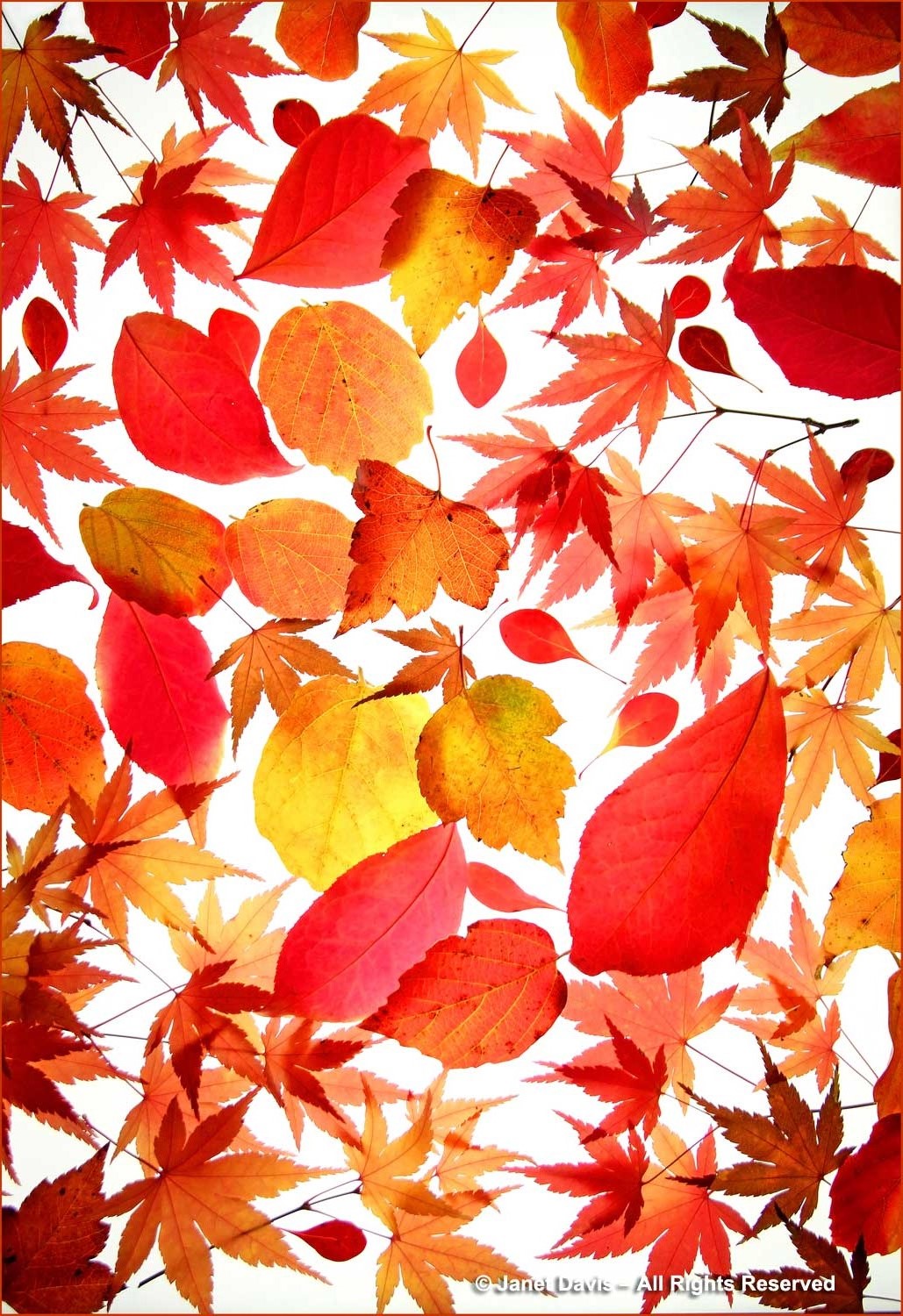
A few years ago I even held a photography show called “Autumn Harvest” featuring a number of my leaf montages.
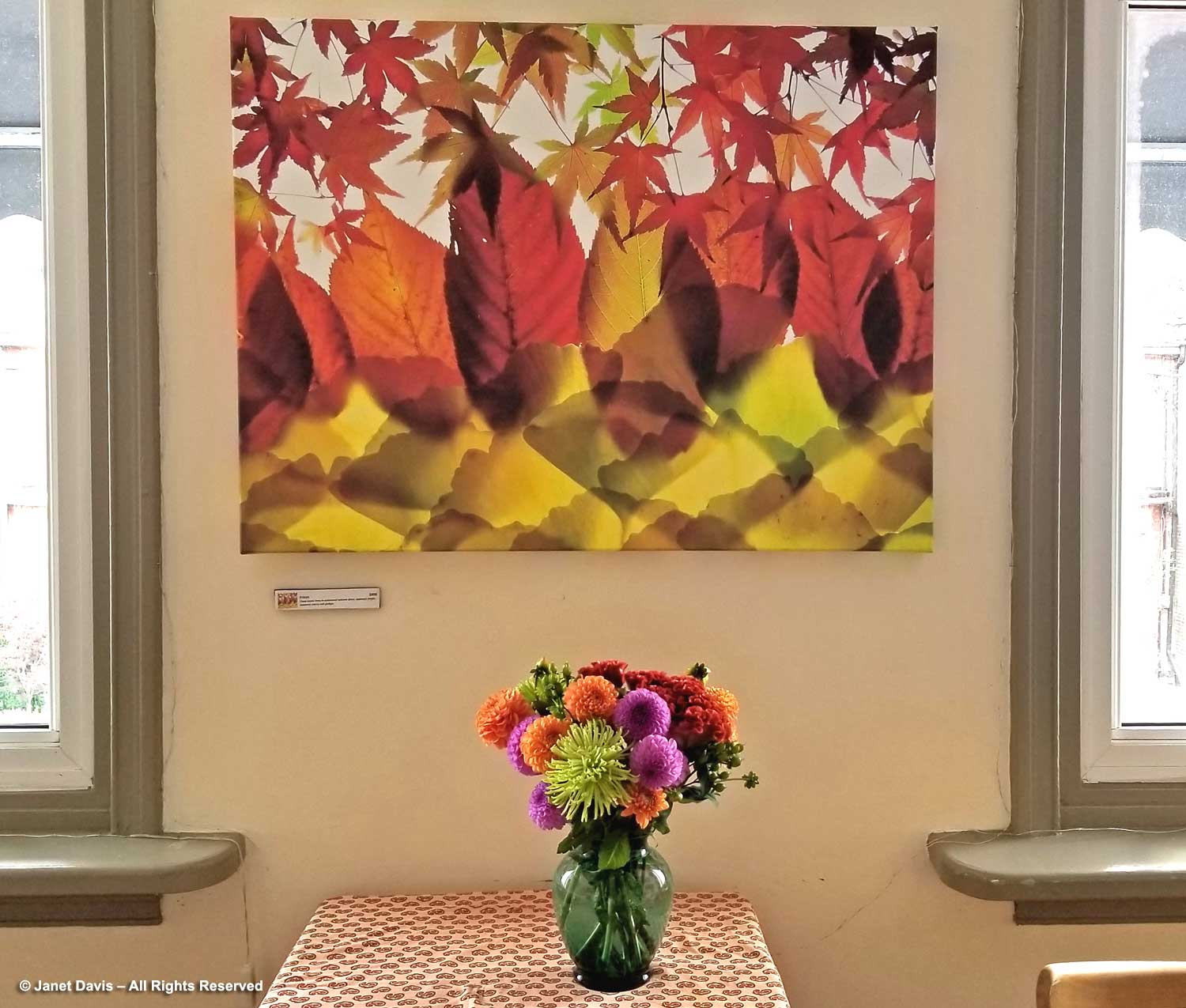
Finally, this week as I walked out onto my front porch and gazed into my garden, this is what I saw– a multi-hued tapestry that shows that nature is the best designer of all. It’s my reward for a gardening season that began seven months ago with the first snowdrops and will soon come to an end with the first hard frost.
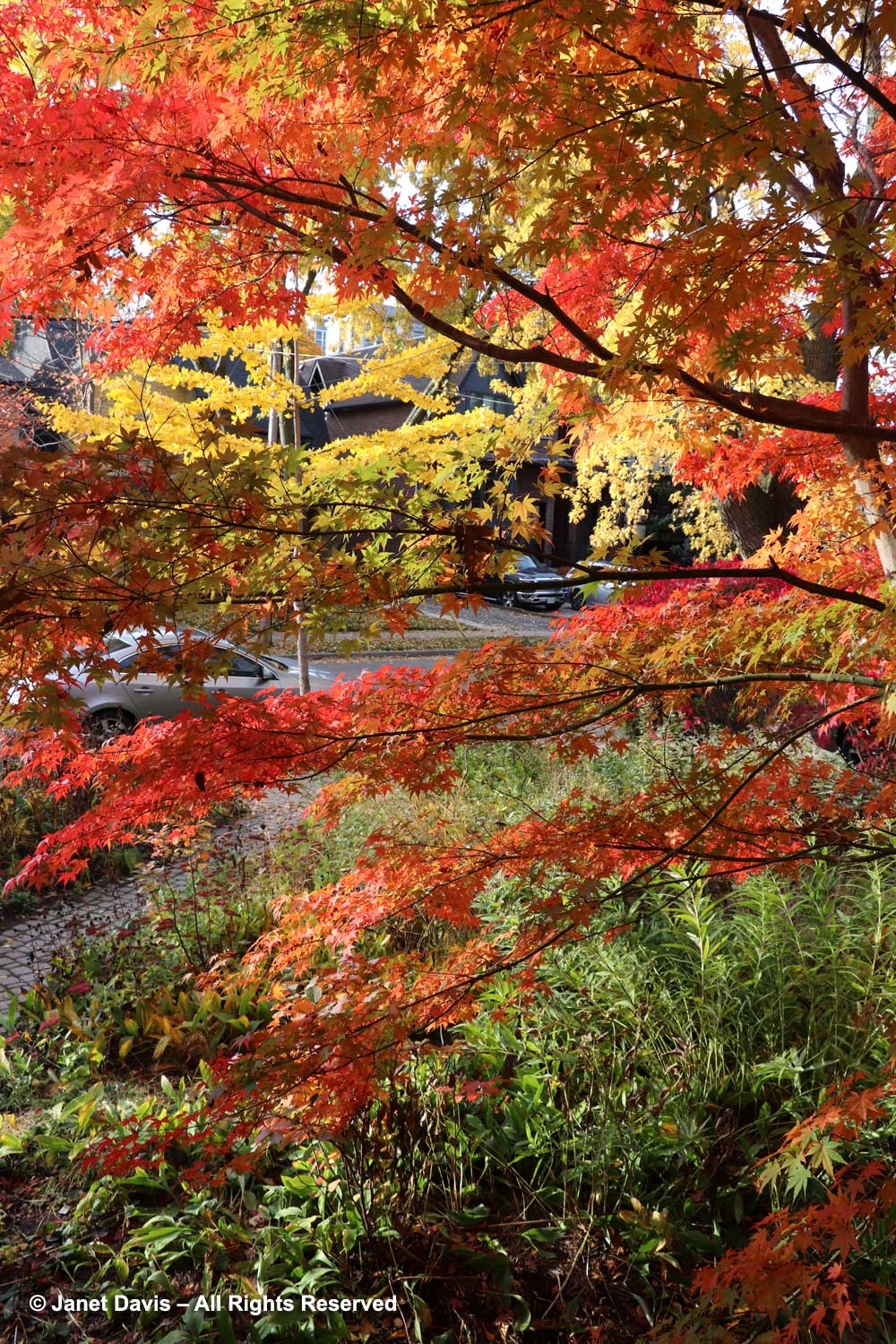
******
My year of fairy crowns is soon drawing to its wintry finale. If you missed a few, here they are:
#1 – Spring Awakening
#2 – Little Blossoms for Easter
#3 – The Perfume of Hyacinths
#4 – Spring Bulb Extravaganza
#5 – A Crabapple Requiem
#6 – Shady Lady
#7 – Columbines & Wild Strawberries on Lake Muskoka
#8 – Lilac, Dogwood & Alliums
#9 – Borrowed Scenery & an Azalea for Mom
#10 – June Blues on Lake Muskoka
#11 – Sage & Catmint for the Bees
#12 – Penstemons & Coreopsis in Muskoka
#13 – Ditch Lilies & Serviceberries
#14 – Golden Yarrow & Orange Milkweed
#15 – Echinacea & Clematis
#16 – A Czech-German-All American Blackeyed Susan
#17- Beebalm & Yellow Daisies at the Lake
#18- Russian Sage & Blazing Stars
#19-My Fruitful Life
#20-Cup Plant, Joe Pye & Ironweed
#21-Helianthus & Hummingbirds
#22-Grasses, Asters & Goldenrod
#23-Sedums, Pass-Along Plants & Fruit for the Birds
#24-Fall Asters & Showy Goldenrod for Thanksgiving
#25-Autumn Monkshood & Snakeroot

What a delightful post! Autumn is my favourite season as well.
Thank you, Aldona! It’s been a fabulous autumn for brilliant colours, hasn’t it?
Such a gorgeous array of autumn colors – I love the artwork you create from them. I think I’ll have to pull out my light box and try some photos with leaves – such a great idea. Wonderful post!
Thanks, Lynn! I have a lot of fun with my light box. I gave my small one to my grandkids for their ‘tracing projects’…. Spiderman, a “cute puppy”, etc. But I kept my larger one. Leaf veins are so cool when they’re illuminated.
Fabulous beautiful post and very educational. You and Mother Nature have done a great job of showing what is available! Thanks for sharing the photos with great information.
Thank you, Trudy! It would be sad for me to have the gardening year end without this celebration of colour.